Digging Deeper
15 Soil Health and Management
Laura L. Van Eerd; Kate A. Congreves; Melissa M. Arcand; Yvonne Lawley; and Caroline Halde
LEARNING OUTCOMES
On completion of this chapter, students will be able to:
- Define the term “soil health” and understand its components
- Compare methods for quantifying soil health
- Explain the connection between improving soil health and the enhancement of ecosystem services
- Identify threats to soil health that causes soil degradation, and how certain practices armour the soil against threats, support diversification or ‘perennialize’ annual cropping systems, and supply increased carbon inputs
- Name the 6C practices of soil health management and explain how each contributes to improved soil health
INTRODUCTION
The potential for soil degradation remains a constant threat to the resiliency and sustainability of agricultural and natural ecosystems. When soil is degraded so too is its health. Efforts to improve or maintain soil health will not only benefit growers or land managers, but will also benefit the environment—a win-win scenario made possible because healthy soils go hand-in-hand with ecosystem services (Table 15.1). In reading this Chapter, you will learn about the history of soil health, its definition, how it relates to soil ecosystem services, and how it is measured and interpreted. In terms of improving soil health, we propose the 6C practices of soil health management as positive actions to improve soil health (Figure 15.1). They are dubbed 6Cs because they start with the letter C, emphasizing the importance of soil carbon and its influence on soil health. Here, you will learn about each of the 6Cs and how they influence soil health. You will quickly see that the concept of soil health pulls together much of what you learned in the other chapters, and the 6Cs provide you with management options that you can apply in your field, garden, or yard to improve soil health and plant productivity.
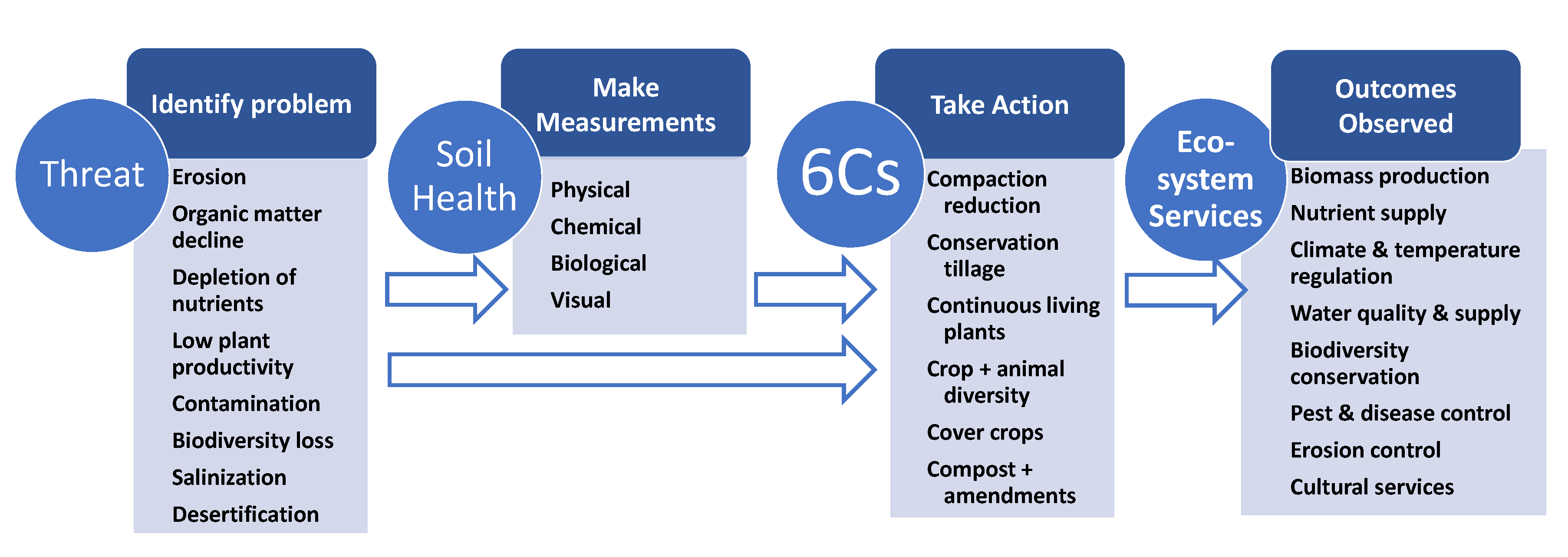
THE IMPORTANCE OF SOIL HEALTH IS LONG RECOGNIZED
The soils in Canada are young, having developed over the 10,000 years or so since the retreat of the last glaciers (see Chapter 2). Canadian society has benefited from the fertility inherent to these young soils, still relatively rich in nutrients and organic matter, that are spread across our present-day landscapes. Still, Canadian farmers and land managers have had to keep a keen eye on how anthropogenic activities have degraded soils over the decades and centuries since the large-scale clearing of forests and native grasslands for resource use and extraction. We have had to respond by adapting new technologies and management strategies that are best suited to the specific climate and soil conditions present within any geographic location, so that the soil functions and capacity to provide ecosystem services are maintained—that the soil is healthy.
Concepts of soil health and the awareness that human actions affect the soil’s functions can be traced back in the written record for millennia. In Canada, those written records are not so old, but the Indigenous people and societies that flourished here had an awareness of the central role soils played in supporting their livelihoods. Prior to European settlement, Indigenous people managed the landscape in myriad ways that directly and indirectly influenced soil properties and functions to serve their needs in promoting food provisioning.
For example, agriculture was present in the Great Lakes region prior to European settlement, where the Haudenosaunee people practiced Canada’s first intercropping systems by planting squash, corn, and beans together. By blending these complimentary plant growth forms together, this practice helps support plant productivity by way of tending to soil nutrients and emphasizes the reciprocity between people and the soil: not only taking from the soil, but also giving back. Centuries later, intercropping is viewed as a reemerging soil health building strategy—and is an example of how plant diversification supports soil health. The linkage among people, soils and plants also extends to animals. On the Canadian Prairies, bison played a central role in shaping grassland ecosystems. These landscapes included Indigenous people that practiced prescribed burning to control woody species while maintaining palatable vegetation for bison grazing (Savage, 2011). Without the human influence on these animal-plant-soil interactions, would the geographic range of the organic matter-rich grassland soils, the Chernozems (see Chapter 10), that support Canadian Prairie agriculture exist as we know them today?
Can You Dig It!

Kirsten Kurtz, manager of the Cornell Soil Health lab, displays a poster of the ‘Three Sisters in Soil’ painting (Left) made by Kurtz and students using only soils. This painting won Food and Agriculture Organization (FAO) of the United Nations’ first global soil painting competition to honour World Soil Day (December 5th). Notice the baskets of corn, beans and squash (the three main agricultural crops of various Indigenous groups in North America) and the multitude of colours all derived from soil. Who knew soil could be so colourful?
In the Three Sisters planting method, three crops benefit from each other. The corn provides a structure for the beans to climb, eliminating the need for poles. The beans provide the nitrogen to the soil, and the squash spreads along the ground, blocking the sunlight and helping prevent the establishment of weeds.
For more info see: https://blogs.cornell.edu/hort/2018/01/12/three-sisters-in-soil-wins-global-soil-painting-competition/
DEFINING SOIL HEALTH
Today, the terms soil quality and soil health are commonly used as synonyms — distinguished mostly by preference rather than meaning. The most widely cited definition is that by Doran et al. (1996) – soil health/quality is the capacity of a soil to function within ecosystems and land-use boundaries to sustain: (i) biological productivity, (ii) environmental quality, and (iii) plant and animal (including human) health. As such, it invokes the linkage between soil functions and soil ecosystem services (Bünemann et al., 2018). Soil functions represent “what the soil does” or “how the soil behaves”, rather than describing what the soil is. Soil functions are bundles of soil attributes and processes, which tie together to serve a role. The soil’s capacity to function powers the extent to which ecosystem services are provided. Ecosystem services, many of which are directly and indirectly provided by soils, support the very survival and quality of all life (Table 15.1, Figure 15.2). Given the complex relationship soils have to ecosystem services, it is no surprise that pinpointing exactly what represents a healthy soil has been challenging. No single soil measurement quantifies soil health, rather it must be inferred from a multitude of soil attributes, processes, and contexts.
Table 15.1. Simplified linkages between a healthy and functioning soil and ecosystem services with example indicators
| Soil functions/roles | Ecosystem service | Goods provided by soil ecosystems | Example soil health indicators |
|---|---|---|---|
| Habitat provisioning, regulation of biological populations; element and organic matter cycling; water cycling | Biomass production | Food, feed, fuel, fibre, and other materials | Primary productivity |
| Organic matter and carbon | |||
| Depth of A horizon | |||
| Element and organic matter cycling; water cycling | Nutrient supply | Supply and flow of nutrients and energy | Organic matter and carbon |
| Active carbon | |||
| Potentially mineralizable nitrogen | |||
| Nutrient concentrations | |||
| Element and organic matter cycling; water cycling | Climate regulation | Capacity to store carbon and regulate greenhouse gas emissions, and mitigate climate change | Organic carbon |
| Respiration | |||
| Total nitrogen | |||
| Habitat provisioning, and regulation of biological populations | Temperature regulation | Mitigates against extreme temperatures fluctuations | Water holding capacity |
| Organic matter | |||
| Water cycling; element and organic matter cycling; soil structure maintenance | Water quality & supply | Vegetation and edaphic factors regulate moisture infiltration, percolation, storage, flow, filtration and the quality of water | Available water capacity |
| Infiltration rate | |||
| Penetration | |||
| Habitat provisioning, and regulation of biological populations; element and organic matter cycling | Biodiversity conservation | Support flora and fauna, and maintain the viability of gene pools | Phospholipid fatty acid analysis |
| qPCR | |||
| Genomics | |||
| Habitat provisioning, and regulation of biological populations; water cycling | Pest & disease control | Regulate the balance and structure of communities and populations, and the activity of predators and prey | Genomics |
| Root assessment | |||
| Soil structure maintenance | Erosion control | Mitigate damage such as flooding or landslides | Aggregate stability |
| Texture | |||
| Organic matter | |||
| Habitat provisioning | Cultural services | Preserve benefits people derive from ecosystems in addition to those mentioned above, such as spiritual enrichment, development, recreation and aesthetic values | Primary productivity |
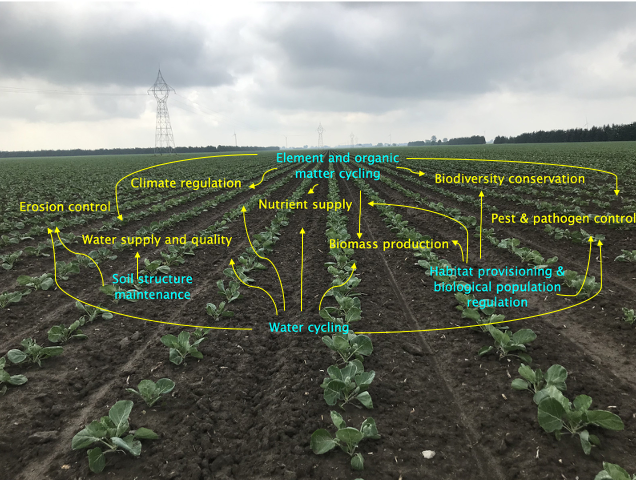
SOIL HEALTH MEASUREMENT AND INTERPRETATION
Soil health research has dramatically expanded in the past three decades (Figure 15.3), and with knowledge comes use. This body of knowledge has largely fueled the uptake of soil health interest and testing by growers and land managers, worldwide. People are now using soil health tests to compare and track soil health measurements as they implement new practices aimed at improving agricultural, ecosystem, and soil resiliency. However, soil health measurements vary greatly and there is no global consensus. Multitudes of approaches exist for monitoring and deciphering a soil’s health status, ranging from narrow and simple to multifaceted and complex (Figure 15.4). Approaches are chosen based on sampling ease, measurement criteria, analytical laboratory facilities, reliability and cost. Regardless of the differences, a single rule of thumb applies: for a soil health test to be meaningful, it must target a specific and relevant soil function or ecosystem service.
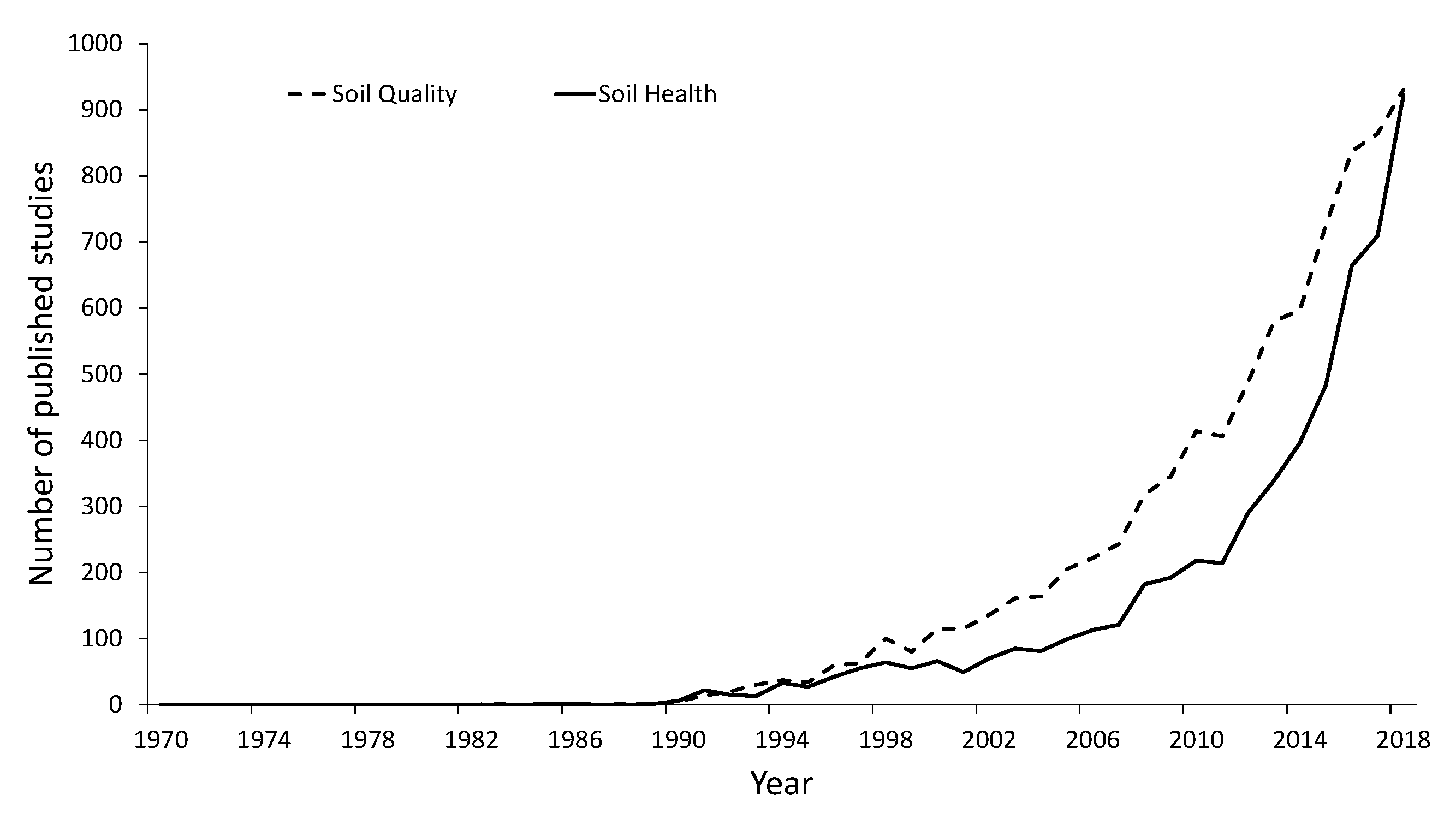
Visual Assessments
There is great value in soil education, and visual assessments of soil health indicators offer an opportunity to learn. Qualitative indicators that can be assessed in the field can provide experiential learning experiences and promote communication between growers or land stewards and specialists. By frequently paying close attention to the soil, visual assessments are a key part of land management planning and refining.
In fields, visual soil assessments generally require little time (less than an hour), minimal tools (a spade or shovel, and water), and offer immediate results. It can be said that visual soil health assessments focus primarily on surface soil (unless pits are dug for a profile assessment) and on physical attributes, compared to biological and chemical attributes. For example, by visually examining a soil sample, one can coarsely evaluate soil texture, aggregation, structure, compaction, and water infiltration—all soil physical components. With a bit more effort and access to simple tools, visual interpretations about chemistry (soil pH) and biology (respiration, earthworm counts) can be done. Some practitioners use reference cards to examine color, combine visual assessments with smell, or look at their soil samples under a microscope. The photo montage here shows visual assessments that rely on color change (Figure 15.4A and 15.4B), and expert knowledge (Figure 15.4C).
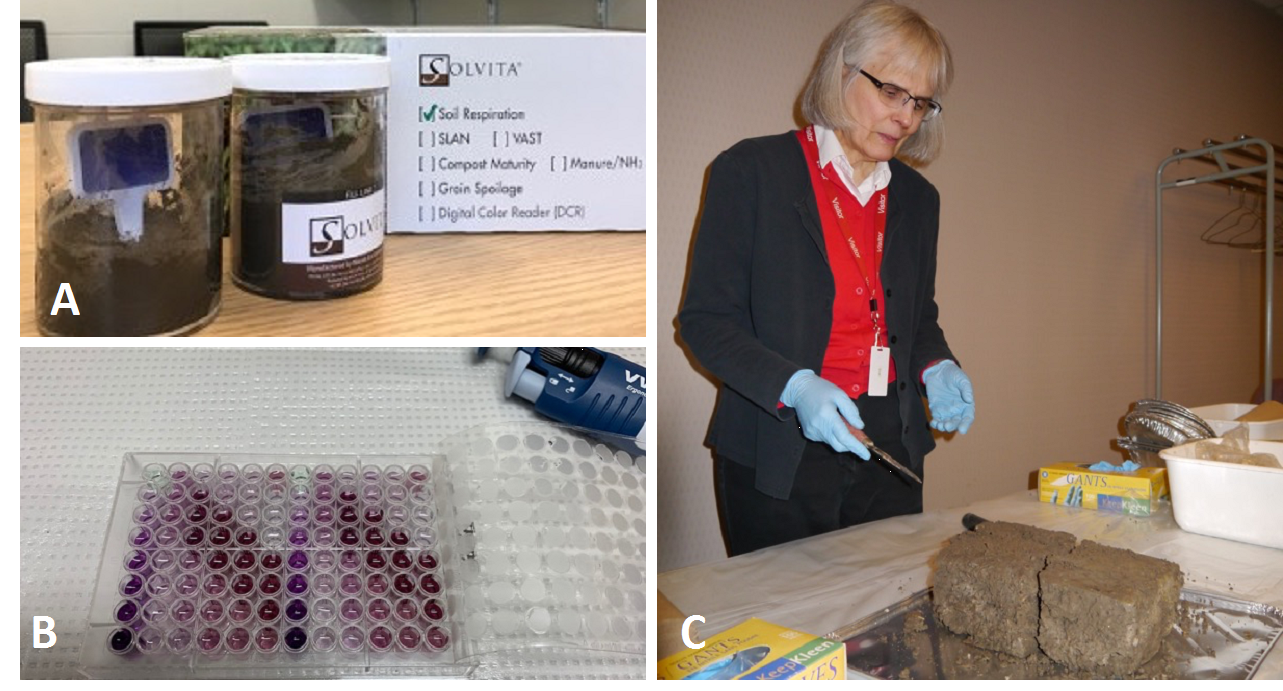
To help with visual soil health assessments, score cards have been developed as a simple tool to guide soil, plant, water, and animal observations on quality. Some score cards also provide a visual key to help minimize misinterpretations by non-experts of soil science.
Not all visual-based soil assessments are low-tech—soil scientist are using the synchrotron or computerized axial tomography (CAT) scans as visual assessment techniques. The same CAT scans used in medicine have been used in soil to measure porosity, connectivity and crusting.
Despite the benefits of visually examining the soil, most visual assessments alone cannot evaluate the degree to which soil ecosystem services are performing—other than possibly erosion control, as inferred from soil physical attributes. As such, visual soil assessments may be more useful in inferring soil health status when combined with other analytical techniques.
Soil Health Tests
Analytical soil tests offer more precise information on soil physical, chemical, and biological pillars of soil health than visual examinations can offer. A list of common soil attributes that are measured via lab-based analytical approaches for each of the three pillars are listed in Figure 15.5, and most of which have already been discussed in earlier chapters of this book (see Chapter 4, Chapter 5, and Chapter 6). Having soil tests can be helpful for management planning; for example, many certified labs offer recommended fertilizer quantities based on soil nutrient levels and growers’ yield goals.
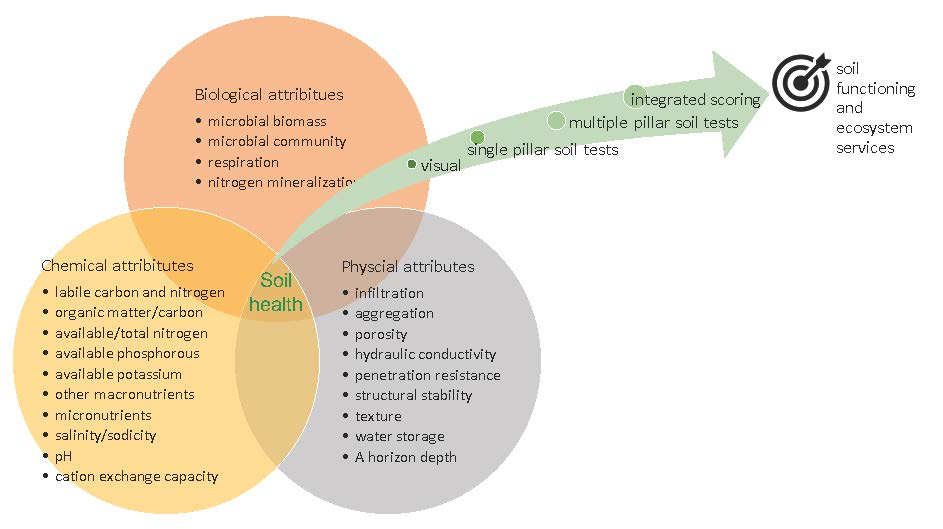
Currently available commercial soil health tests offer insight into one or more soil attributes (Table 15.2). These commercial tests are often biology- or chemistry-focused tests that quantify soil attributes and may be useful for monitoring trends over time and from one location to another. However, all three pillars of soil health should be considered for a holistic interpretation of a soil’s health status. With this in mind, it must be acknowledged that increasing the number of attributes can increase the complexity of relationships between indicators, which can complicate interpretation and therefore management recommendations. Ideally, soil attribute data should be linked with soil function and ecosystem service performance to understand soil health in a more meaningful way.
Table 15.2. Soil health indicators that are included in various soil health tests. Which indicators would your soil health test include?
Integrated Scores of Soil Health Tests
To be useful, soil health indicators must be clearly interpreted and ideally expressed relative to reference values. Reference values for soil attributes can be derived from an undisturbed soil (not impacted by anthropogenic activity—which may be difficult to find, or otherwise not reflective of optimum soil functioning) or a soil with superior primary productivity and environmental performance. As a framework for soil health scoring, soil health indicators at any given site can be compared to either a reference soil, or to the statistical distribution frequency of the given indicator (Figure 15.6) from a range of samples under comparable land-uses or regions.
A multifaceted approach to soil scoring involves the establishment of standard non-linear scoring functions, which have three general shapes (Figure 15.6) and represent indicators where: (i) more is better (e.g., soil organic matter), (ii) optimum is best (e.g., nutrients, pH), and (iii) less is better (e.g., salinity). The shape of the curve for each soil indicator is informed by expert opinion and/or literature. Each soil attribute value is transformed into a relative score based on where it falls on the scoring curve—as derived from the distribution frequency for a particular region or land-use. As such, when scoring curves are based on regional datasets – like the Cornell University’s Comprehensive Assessment Soil Health (CASH), the resulting scores (0 to 100) indicate the rank relative to that particular region. When integrating the scores of many soil attributes, all the scores are averaged. The higher the score, the better the soil health.

Can You Dig It!
Soil Your Undies
Well that gets your attention. Soil Your Undies started by the Innovative Farmers Association of Ontario in 2017 to encourage people to learn more about their soil (http://www.omafra.gov.on.ca/english/premier_award/2017/events/h/ifao.htm). By burying cotton underwear in soil for up to 2 months, you can see how biologically active your soil is. Here’s how it works. Cotton is plant-based and thus carbon-based. Soil fauna and microbes feed on carbon, so the more degraded your underwear the more active your soil. Collaborating with Ontario Ministry of Agriculture, Food and Rural Affairs (OMAFRA) Soil Management Specialist Anne Verhallen, soil microbiologist Dr. Lori Phillips (lower Right) quantified the microbial diversity associated with buried underwear. She extracted DNA from soil, the soil attached to the buried undies, the “undie-sphere”, and from the buried undies. She used a combination of sequencing and quantitative PCR to examine microbial life in these soils. The figure below shows two soils from one farm in southwest Ontario with similar management (conservation tillage, 3-crop rotation and cover crops). Underwear decomposed more rapidly in biologically diverse soils, which had up to 15% more taxa than soils where underwear remained ‘wearer-friendly’. These soils also had a higher abundance of fungi that specialize in breaking down carbon compounds (saprotrophs) as well as a high abundance of bacteria that free up the nitrogen these fungi require. For example, she observed that carbon decomposers (e.g., saprotrophic Mortierella fungi) and bacterial nitrifiers (such as Nitrosomonas spp.) were twice as abundant in soils where the carbon-rich undies decomposed completely in 2 months (Panel A) compared to where decomposition was incomplete (Panel B).
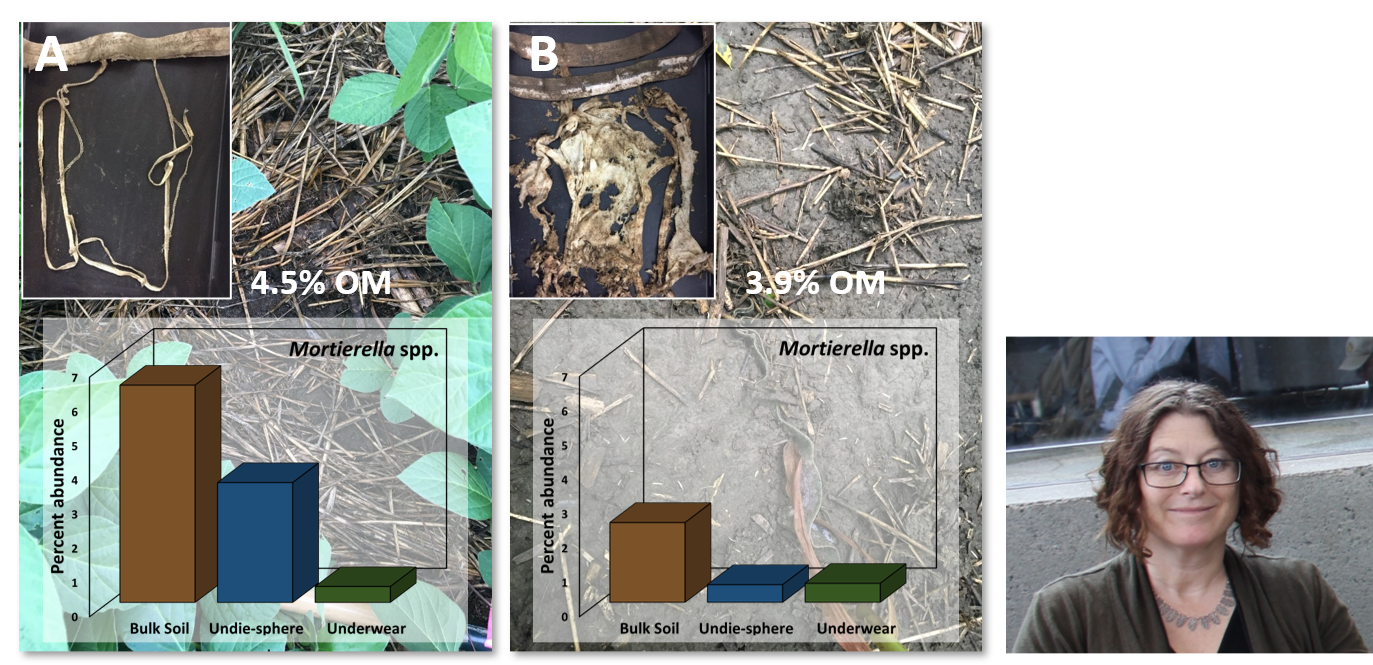
Pretty nifty what your underwear can tell you. To give it a try, see the exercise at the end of this chapter.
SOIL HEALTH MANAGEMENT
We know that the activities of humans impact the soil; the goal is to minimize threats to soil health that result in soil degradation (or poor soil health). The main degradation threats to soil health include: erosion, compaction, soil organic matter decline, depletion or excess of nutrients, biodiversity loss, salinization, desertification and contamination or pollution (Figure 15.1)—many of which have been discussed in previous chapters. In this chapter we focus on land management practices that exacerbate or ameliorate these soil problems. Practices that maintain or improve soil health will (i) protect the soil against threats, (ii) support diversification or ‘perennialize’ annual cropping systems, and/or (iii) build soil carbon (Table 15.3). Here, we introduce six practices that land managers can use to build soil health and thereby protect against soil degradation (Figure 15.7). Purposefully, these six practices start with the letter C to emphasize the role of carbon in soil health. An explanation of what each practice is and how it enhances soil health follows in the sections below. These 6C practices can be implemented in the field, garden, yard or on any managed soil—or can be combined together, for a positive influence on soil health (Figure 15.8). As you learn about each, it is very important to know that these practices in combination or partial combination will interact to influence aspects of soil health in various ways.
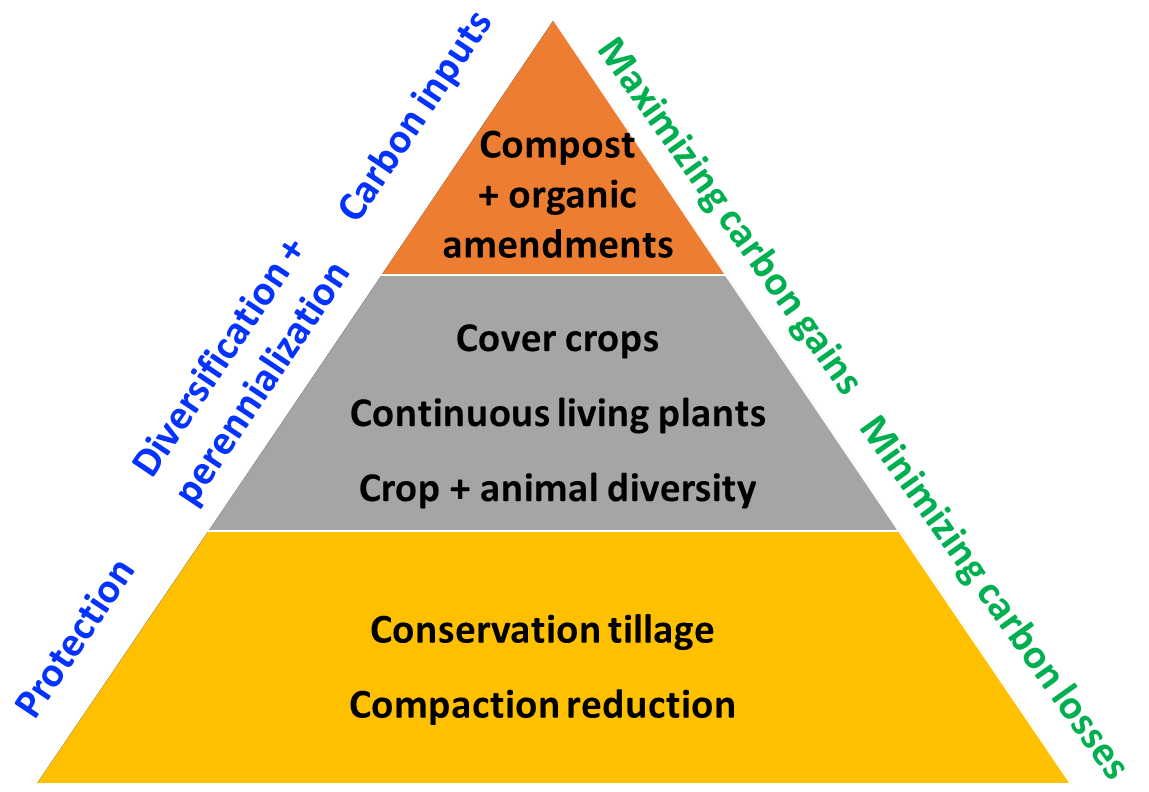
Table 15.3. The 6C management practices and principles that can be used to help achieve soil health
| 6C management practices | Soil Health Principle | ||||
|---|---|---|---|---|---|
| Protection | Diversity + Perennialization | Building Carbon | |||
| Maximize soil cover | Minimize soil disturbance | Carbon inputs + gains | Minimizing carbon + soil losses | ||
| Compaction reduction | *** | * | * | ||
| Conservation tillage | ** | *** | * | ** | |
| Continuous living plants | ** | ** | *** | ** | ** |
| Cover crops | *** | ** | * | ** | |
| Crop +animal diversity | *** | * | * | ||
| Composts and amendments | * | *** | * | ||
| ***principle goal and benefit; **expected benefit; *likely benefit | |||||
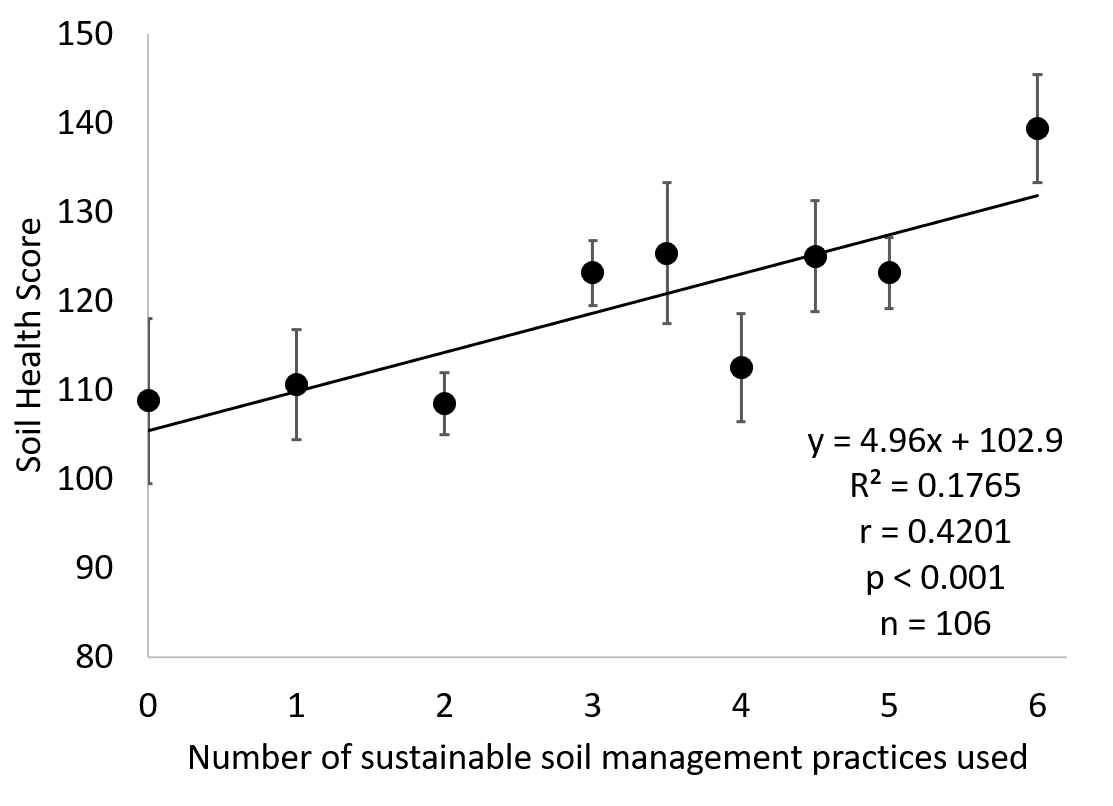
6C Strategies
6C–1: Compaction Reduction
 What is soil compaction? As discussed in Chapter 4, soil structure and porosity are critical components of soil. Compaction occurs when a force is applied that presses soil particles together causing soil pores to collapse (i.e., pores are reduced in size and number), and bulk density to increase. As pores are reduced, the volume of water and air is reduced as is the space available for root growth. Soil compaction limits the rooting depth of plants and makes living conditions for the plant and microbial life in soil more challenging. Soil compaction can occur at the soil surface, at the depth of tillage (typically 20 cm), or even deeper in the soil depending on the type of equipment or management practices involved. As we will outline below, reducing soil compaction is an important but challenging step in improving soil health.
What is soil compaction? As discussed in Chapter 4, soil structure and porosity are critical components of soil. Compaction occurs when a force is applied that presses soil particles together causing soil pores to collapse (i.e., pores are reduced in size and number), and bulk density to increase. As pores are reduced, the volume of water and air is reduced as is the space available for root growth. Soil compaction limits the rooting depth of plants and makes living conditions for the plant and microbial life in soil more challenging. Soil compaction can occur at the soil surface, at the depth of tillage (typically 20 cm), or even deeper in the soil depending on the type of equipment or management practices involved. As we will outline below, reducing soil compaction is an important but challenging step in improving soil health.
Why is reducing soil compaction important for soil health? As you recall from Chapter 6 on Soil Biodiversity, all of soil life happens in soil pores. The water and gases that plants and soil microorganisms depend on move through the soil pores. Compacted soil limits voids and pore space, movement of water and diffusion of gases. This can lead to saturated soils and if water cannot drain, then anaerobic conditions may result. All these conditions limit root and microbial growth. Adequate soil pore space is very important for soil health because it supports life.
Plant roots have a harder time pushing through compacted soil, more force is required (Figure 15.9). Think about a path through a green space on your campus where students are walking every day (Figure 15.10). When the soil is wet, the force of your footsteps (and thousands of others) compress the soil and cause compaction. Next time you walk by, take a look at the appearance of the soil and plants in the path and compare conditions a few feet away from the path. Perhaps the grass has stopped growing in the path and only “weedy” plants that have adapted to growing in compacted soil conditions are present. The next question is what will campus gardeners do to solve this soil health problem?
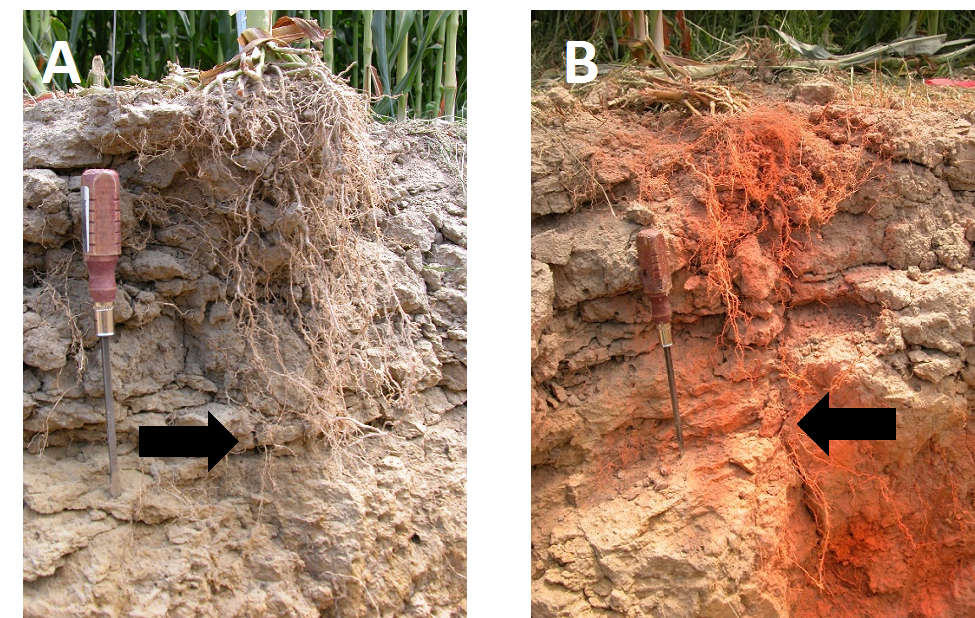
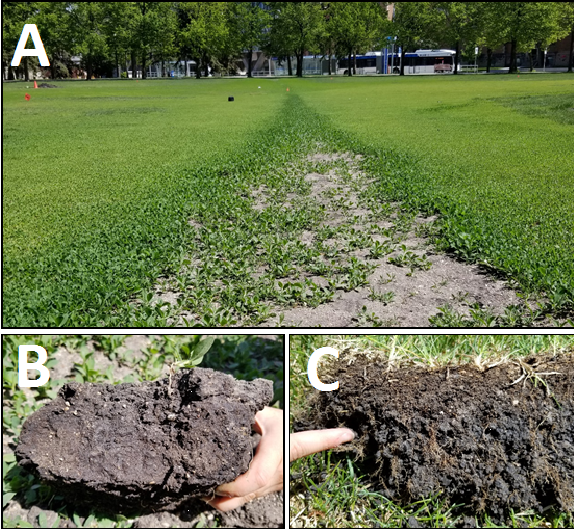
How to reduce and alleviate soil compaction?
Most would say that avoiding soil compaction in the first place is the best solution. That means avoiding traffic in fields or on your campus green space when soils are wet. After soil compaction occurs, something needs to happen to restore pores (voids) that were lost. In many parts of Canada, the freezing and thawing acts to loosen the soil and help alleviate soil compaction. Where this does not occur or if soil compaction occurs deeper in the soil, then a “deep ripper” tillage implement, such as a chisel plow, is often used to fracture or break up compacted soil layers (Figure 15.9B, 15.11A). Deep tillage, called subsoiling, with a chisel plow is expensive because it takes a lot of fuel and time. Tillage also needs to happen at a time of the year when the soil is dry enough to fracture and break up the plow pan (compaction layer), rather than smear and create a new deeper layer of soil compaction if soils are too wet. If the management practices that caused soil compaction in the first place do not change after the subsoiling, then action to alleviate compaction will likely be needed again after a few years.
An alternative approach to alleviating soil compaction is using plant roots to create channels (bio-pores) through layers of soil compaction (Figure 15.11B). This is called biodrilling or biological tillage (Cresswell and Kirkegaard, 1995; Chen and Weil, 2010). After the plants die and decompose, if these bio-pores are not disturbed through tillage, plants that grow the following year will grow through them to reach the soil underneath the compaction layer (Figure 15.12).
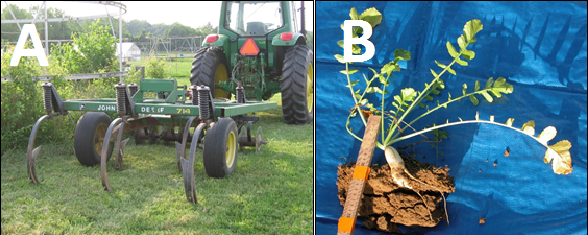
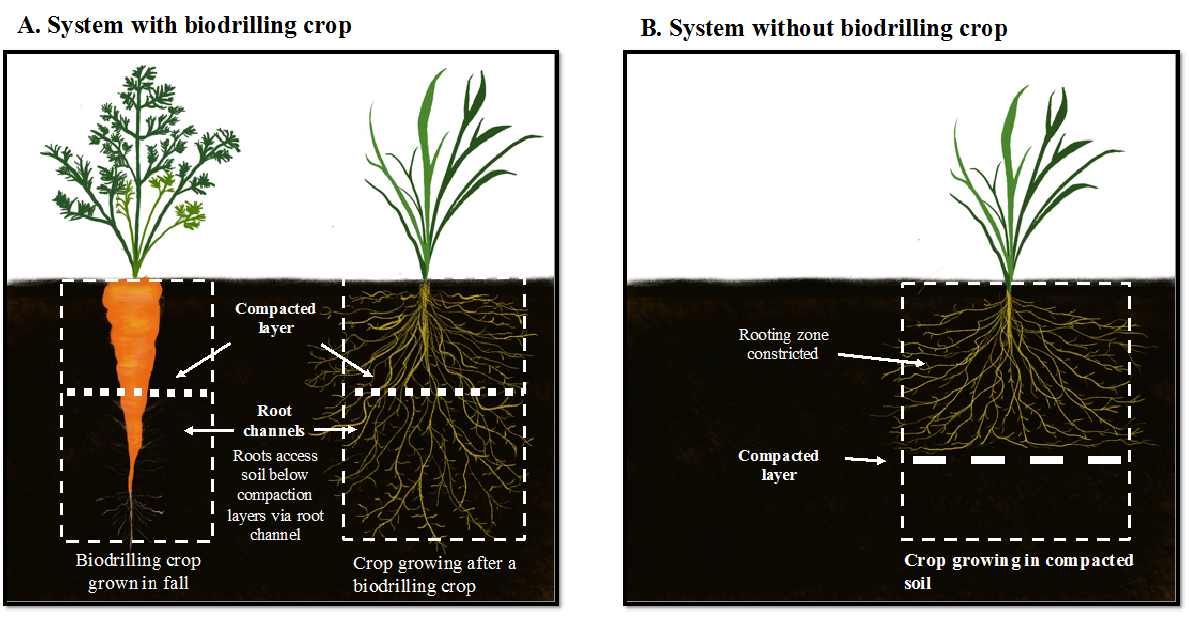
You may be asking yourself the question, if soil compaction is bad for root growth then why can we use plant roots to solve this problem? There are three key factors that make biodrilling possible. First, plant roots must be growing at a time of the year when soils are moist and it is easier for plant roots to push through the tillage pan. If you have ever tried to push a stick into soil, you would know that more force is needed when the soil is dry compared to when the soil is wet. Second, not all plant roots have the same ability to push through compacted layers (Chen and Weil, 2010). Some plants have more root pressure than others to push through root restricting layers. For example, tap-rooted plants such as forage radish (Photo 11.11B), commonly used as cover crops had about twice as many roots as fibrous-rooted cereal rye cover crops at the 15–50 cm depth under compacted soil conditions (Chen and Weil, 2010). Third, leave these macropores intact by avoiding tillage in order to accumulate more and more root channels over time.
Why is it hard to reduce soil compaction? Think about your walk across that green space on campus. You should be walking on the side walk, especially when the soil is wet after a rain, but you take a short cut because you are late and you need to get to class. Or maybe it’s just habit and you don’t even think about it. It’s the same with farmers or gardeners or landowners. Sometimes soil conditions can be too wet when something important needs to be done in the field. An increase in farm size plays a role, as having more ground to cover often means that in order to complete field operations in a timely manner, field activities like seeding, spraying, or harvesting may occur when conditions are too wet. As the weight of farm equipment has been increasing over recent decades so too has the force exerted on the soil. Monitoring axel loads and tire inflation on field equipment as well as avoiding field activities when soils are wet can help avoid soil compaction.
Farmer Profile

Controlled traffic farming is a new approach to addressing soil compaction. Controlled traffic farming limits where all field equipment is driven and intentionally concentrates soil compaction in permanent tramlines (think roadways but without gravel or pavement). This eliminates compaction because there is no wheel traffic in the rest of the field. Adam Gurr, who farms near Brandon, Manitoba, was concerned about the impact that soil compaction was having on soil health and plant performance on his farm. Adam now uses controlled traffic farming with global positioning system (GPS) to direct all of his farm equipment to travel on permanent tramlines in his fields.
Adam decided to adopt controlled traffic farming because it reduced soil compaction, reduced fuel consumption, and increased his ability to access fields (especially in wet years). He has measured the positive soil health impacts including quicker water infiltration, lower bulk density, and greater crop yields on his farm.
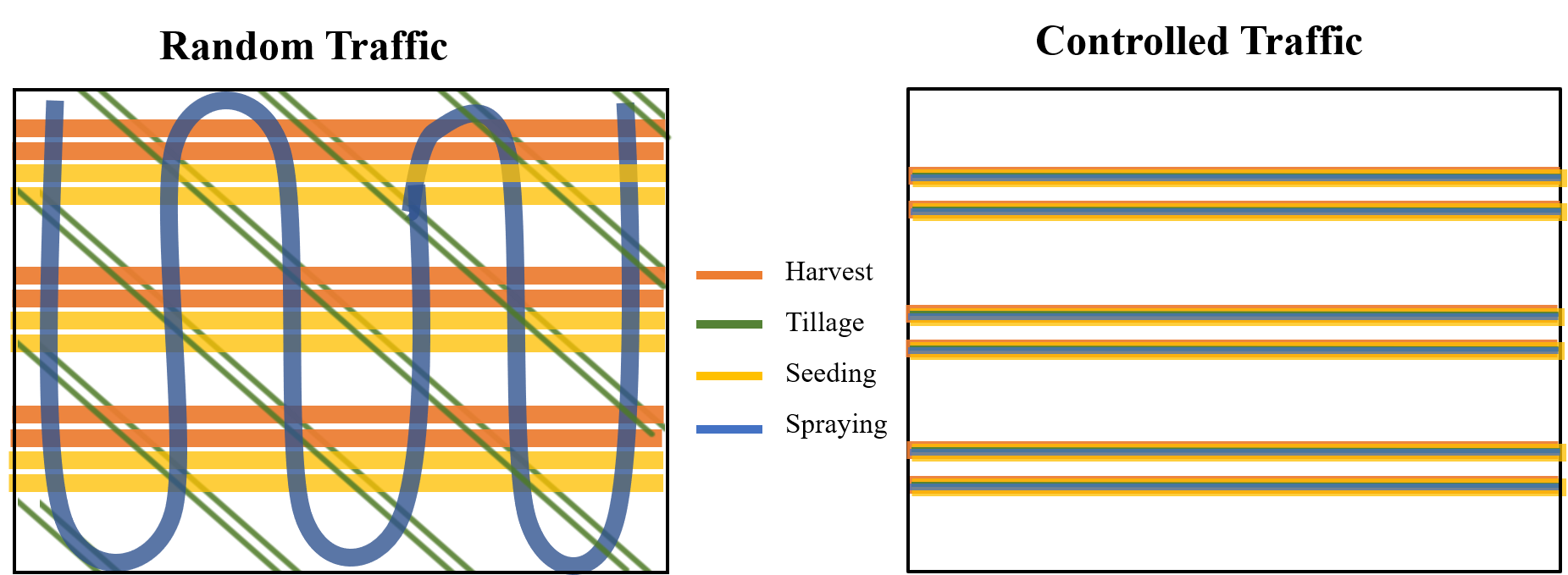

Converting to controlled traffic farming may not work for every situation or farmer. The majority of farmers adopting it are already practicing reduced or no-till farming. It can also take several years to purchase or adapt all of your field equipment (tractors, sprayers, harvesters, grain carts) to have the same wheel width and be able to line up on tramlines.
6C–2: Conservation tillage
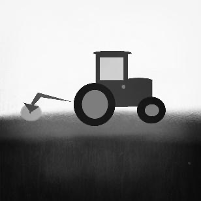 Soil tillage is the mechanical mixing of soil to various degrees. It is primarily used to prepare a good seedbed (Figure 15.13) ahead of seeding or transplanting, but also serves other purposes, such as: controlling weeds, breaking up soil compaction or crusting, facilitating faster decomposition of crop residues or organic amendments, and to incorporate amendments and soil-applied pesticides into the soil. Tillage can increase soil aeration, decrease soil moisture, and promote faster warming in the spring, leading to earlier or more uniform plant germination. Tillage also stimulates soil microbial activity including the breakdown of soil organic matter important in maintaining soil structure.
Soil tillage is the mechanical mixing of soil to various degrees. It is primarily used to prepare a good seedbed (Figure 15.13) ahead of seeding or transplanting, but also serves other purposes, such as: controlling weeds, breaking up soil compaction or crusting, facilitating faster decomposition of crop residues or organic amendments, and to incorporate amendments and soil-applied pesticides into the soil. Tillage can increase soil aeration, decrease soil moisture, and promote faster warming in the spring, leading to earlier or more uniform plant germination. Tillage also stimulates soil microbial activity including the breakdown of soil organic matter important in maintaining soil structure.

The method and timing of tillage will depend on soil type, cropping system, and grower goals. Although tillage is often used to solve problems (such as described in the compaction section), it can also create problems for soil health and plant productivity. By bringing crop residues deeper into the soil, tillage ‘removes’ soil protection that would otherwise protect the soil from water or wind erosion, thereby leaving the soil vulnerable to loss. Tillage also disrupts soil aggregates and arbuscular mycorrhizal fungi networks, both of which are important for maintaining soil structure in the long run. Tillage when soil conditions are not ideal (too wet or too dry) can lead to compaction, resulting in negative impacts on plant growth and soil health. To reduce these problems, farmers are increasingly reducing the number and intensity of tillage operations and adopting conservation tillage practices to conserve soil and water mainly by retaining at least 30% of the soil surface covered by plants or crop residues (Figure 15.14). In addition to the mechanism of improving soil health, we will outline the multitude of tillage practices and the reasons for regional and cropping system differences.
Types of conservation tillage: Conservation tillage is an umbrella term for many different forms of tillage that reduce the frequency or intensity of soil disruption, relative to conventional tillage or plowing (Figure 15.15). By reducing the number of passes over the field, tillage frequency can be reduced; by reducing the depth of tillage, tillage intensity can be reduced. Conventional tillage or plowing typically inverts the soil to approximately 20 cm depth. For more information on various tillage practices please see glossary and resources at the end of this chapter.
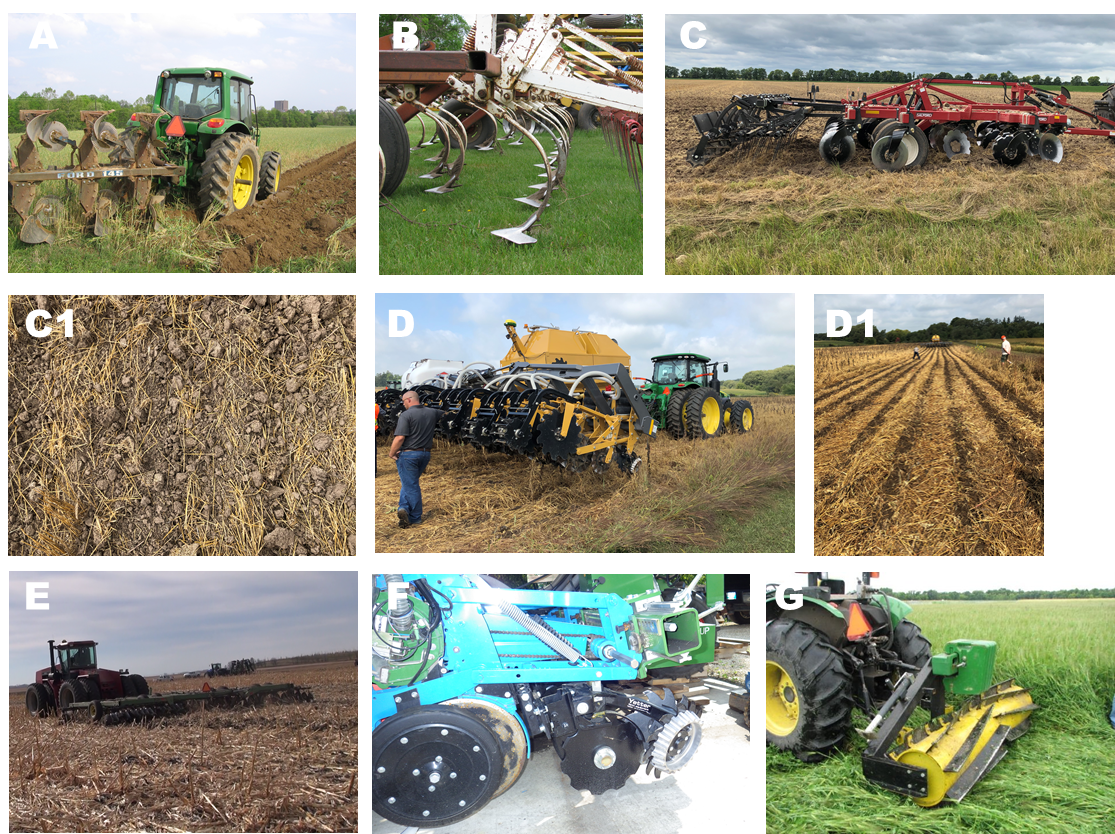
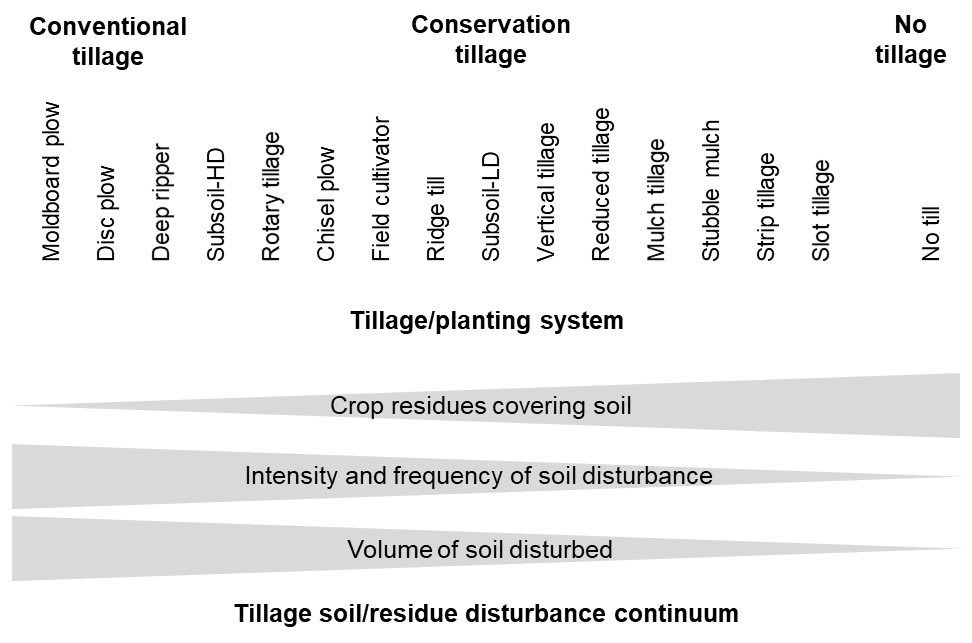
Context matters: Within Canada, the adoption of conservation tillage practices varies widely by region, and depends on climate, soil types, crop rotation, and cropping system. For example, no-till has been widely adopted by growers in drier regions (i.e., western Canada) because water is a limiting resource for crop growth, and growers use conservation tillage as means to conserve soil moisture for plant growth. But, in humid regions, such as British Columbia and eastern Canada, water is typically in excess in the spring, so many growers use tillage, mainly in the fall, to hasten soil drying so they can plant sooner. Consequently, the adoption of conservation tillage practices is relatively lower in eastern Canada than the western counterparts (Statistics Canada, 2016 Table 32). Having said that, farmers in humid climates are using conservation tillage. With time, soil health has improved with no-till, most noticeably reduced crusting and greater infiltration rates which allow soils to dry whereby planting is not delayed.
Reasons for regional differences not only reflect the differences in climate, but also differences in the types of crops that are predominantly grown. For example, the small grains and oilseeds produced in western Canada do not leave as much crop residue on the soil surface after harvest, compared to grain corn that is grown in eastern Canada. As such, managing large quantities of crop residues via tillage becomes an important part of preparing a seedbed.
Certain cropping systems are better suited to conservation tillage than others. For example, conservation tillage is well suited to grain and oilseed crop rotations where weeds can be chemically controlled. Likewise, in organic farming systems or systems where chemical weed control options are limited (e.g., specialty or vegetable crops), weeds are managed mechanically via tillage. Tillage practices are still common in vegetable cropping systems where small-seeded crops need a fine seedbed and good soil contact for germination, or where transplant equipment needs to deeply nestle a seedling into the soil. In these aforementioned systems, tillage is also used to incorporate crop residues to mitigate insect and disease pressure. These factors as well as time and cost of converting to conservation tillage will be front of mind when making the decision to switch practices.
How does conservation tillage enhance soil health? Conservation tillage maintains crop residues on the soil surface, providing protection (Table 15.3; Figure 15.7). The layer of crop residues, organic material or plants on the soil surface improves water infiltration by slowing surface run-off and wind speeds, and it retains moisture by reducing soil water evaporation and salinization in arid conditions (see continuous living plant section). The crop residues that remain on the soil surface provide a food source (carbon) and habitat for macrofauna and microorganisms, which is beneficial during the decomposition of crop residues as biological activity helps to form soil aggregates—a key to soil structure. Reducing soil disturbance also decreases the breakdown of organic matter already present in the soil and helps to maintain soil structure and aggregate stability. Adopting conservation tillage practices can improve soil health through a range of mechanisms, such as by influencing water cycling, soil structure, organic matter and nutrient cycling, habitat provisioning and biological population regulation (these are all soil functions; see Figure 15.2, highlighted functions in blue). Because conservation tillage influences many soil functions, it is not surprising that conservation tillage improves soil health—and that studies have generally found higher soil health scores under no-till than plow tillage (Figure 15.16)
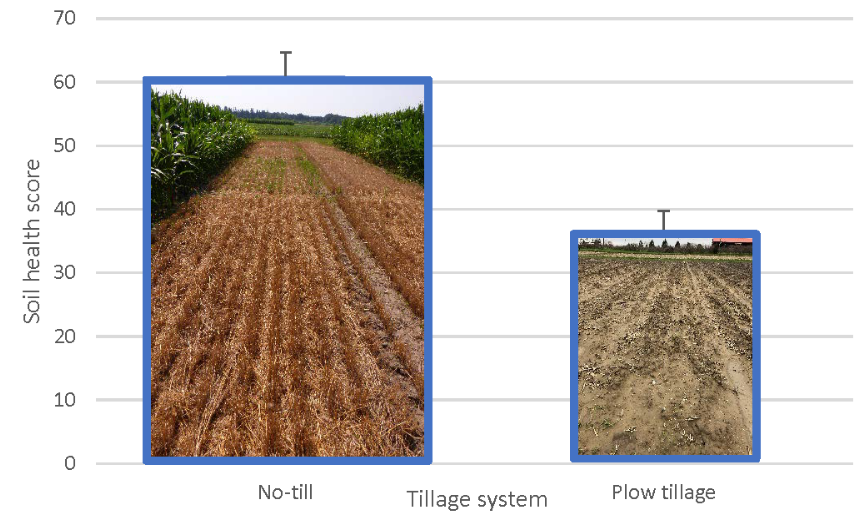
It is universally accepted that conservation tillage minimizes erosion, which minimizes soil carbon losses. It is not difficult to imagine that if long-term research trials were conducted on sloped land subjected to erosion that great differences would be observed in soil health, organic carbon and primary productivity between conservation tillage and plow tillage. Given the regional climatic, soil, and production system differences outlined above, it should be expected that regional differences associated with the impact of no-till on soil organic carbon accumulation and soil health also occur. It is not possible to separate if this effect is climate-driven or simply due to the different crop rotations employed in various regions resulting in different quantities of carbon inputs. Regardless, surface soil health indicators and scores point to the value of adopting conservation tillage practices.
Sampling depth is an important consideration when comparing tillage systems. Many soil health tests only require sampling to the 0–15 cm depth, but plowing mixes the soil to 20 cm—and some tillage practices like subsoiling will mix soil to the 40 cm or 60 cm depth. The impact of tillage on soil health indicators will depend on the level of soil mixing brought by specific tillage practice. Nonetheless, in cases where conservation and conventional tillage practices have comparable levels of soil carbon throughout the whole profile, it is the surface levels of organic carbon under conservation tillage that help support many soil functions. Moreover, plant roots mainly occupy surface soil, where exudates and other carbon compounds are deposited. So, the question is: are the higher soil health scores that are often observed under conservation tillage vs. conventional tillage overestimated when soil sampling focuses only on the surface soil layers? The answer is still under debate in the scientific literature.
Unlike the other 6C soil health management strategies, there is greater uncertainty as to the magnitude of effect of no-till on organic carbon (Ogle et al., 2019) and soil health. Some of the uncertainty is due to differences in management among research trials. As previously stated, residue management can be challenging in no-till systems, which often lowers plant stands and primary productivity. With lower primary productivity, so too are the soil carbon inputs. Over time, researchers and farmers have largely overcome the challenges of residue management to establish a good seedbed by modifying planter equipment (Photo 15.14F). Ultimately, the benefits that conservation tillage imparts on soil ecosystem services (including plant productivity) drive the decisions to adopt this practice.
Challenges of conservation tillage: Transitioning from conventional to conservation tillage requires the purchase or modification of farm equipment to manage crop residues. Transitioning also requires a period of learning through trial and error. Moreover, there is a transition for soil life too, where microbial populations change. An obvious example is the change from annual to perennial weeds when tillage ceases. Practitioners of no-till often refer to two phases: a ‘transition period’ and ‘mature’ no-till. Management and challenges are greatest during the transition period. The greatest soil health gains are observed in the mature no-till phase, but it takes time and investment to get there.
As eluded to in the Context Matters section above, challenges with adopting conservation tillage practices will also vary among soil types and management systems. The transition period of converting to no-till systems is particularly challenging for poorly drained clay textured soils. Another challenge in no-till systems is the acidification of the soil surface, caused by the application of ammonium-based fertilizers and the stratification of nutrients such as P and K, which results in greater concentrations at the soil surface. Adopting no-till in organic farming systems still remains a challenge across Canada (Halde et al., 2015, 2017).
Conservation tillage is often described as a system rather than its individual practices or equipment. Any change in tillage impacts many other aspects of the cropping system that will also need to be adapted (e.g., cultivar selection, application of mineral fertilizers, weed control). Note that this concept also applies to the adopting other 6C strategies of soil health management. In addition to being prepared and dedicated, any change to an operation requires evaluation of the entire system, in order to be successful.
6C–3: Continuous Living Plants
 In nature, soil is usually kept covered by living plants and plant residues. Think of a forest with its trees, understory species, and blanket of leaf litter or think of a native prairie grassland with its extensive root systems. Soils in these ecosystems have a continuous cover of mostly perennial plants and a layer of plant litter that remains at the soil surface. Continuous living plants protect the soil against disturbance, while tightly cycling nutrients and water and provide a steady supply of organic inputs from roots and litterfall to build soil organic matter (Table 15.3).
In nature, soil is usually kept covered by living plants and plant residues. Think of a forest with its trees, understory species, and blanket of leaf litter or think of a native prairie grassland with its extensive root systems. Soils in these ecosystems have a continuous cover of mostly perennial plants and a layer of plant litter that remains at the soil surface. Continuous living plants protect the soil against disturbance, while tightly cycling nutrients and water and provide a steady supply of organic inputs from roots and litterfall to build soil organic matter (Table 15.3).
In contrast, agricultural systems where annual plants are typically grown, there are periods during the year in the early spring and late fall when living plants are not growing. Moreover, some farmland, largely on the Prairies, is intentionally left as fallow land to conserve soil moisture for subsequent grain crops. As far back as the early 20th century, however, soil scientists could measure the negative impact of frequent fallow on soil organic matter levels in prairie crop rotations (Janzen, 2001). The concerns and warning from these early scientists are linked to our modern concern and interest in soil health. The absence of living plants and their root systems means that soils are more susceptible to erosion. At the same time, there are no plants taking up nutrients or contributing organic matter—putting soil health at risk. Continuous living plants, primarily by perennializing cropping systems, is the only 6C soil health management strategy that contributes to all three soil health principles (Table 15.3) protect soil, diversity + perennialization and building carbon. We will outline how keeping continuous living plants supports soil health and what management practices can be employed to better approximate perennialization even in annual cropping systems. This soil health strategy lays the foundation for the other 6C centred around plants (Cover crops and Crop + animal diversity).
The root of the solution: Healthy soils support plant growth and healthy plant roots. This concept can also be flipped around. Plant roots support soil development and soil health (King et al., 2020). Increasing the duration, number, and type of plant roots in soil through the presence of continuous living plants is an important ingredient for building healthier soil. Living roots connect the soil and the soil ecosystem to a plant’s infrastructure, which collects solar energy through photosynthesis. Plants allocate roughly 40% of their net photosynthetic carbon towards roots (Jones et al., 2009)—this is a large amount of carbon that can contribute to increasing soil carbon and soil health. In general, perennial crops provide more carbon inputs than annual crops because their root systems are not only larger, but for a much longer time the plant is able to photosynthesize and release carbon to the soil from decomposition of aboveground residues, dead roots, and rhizodeposits from live root systems. The carbon released serves as fuel for the heterotrophic soil microbial communities (recall Chapter 6). In turn, the soil microbial communities can enhance soil health and function by cycling nutrients, building soil organic matter, and anchoring soil aggregates to build soil structure (see Chapter 4). The longer a crop is present in the soil, the more carbon it adds to build soil organic matter and to fuel important microbial-driven processes that underpin soil health.
Roots anchor the plant to the soil, in turn stabilizing the soil and reducing exposure to wind and rain erosion. Perennial crops can outperform no-till annual cropping in improving soil physical properties such as aggregate stability (Arshad et al., 2004; King et al., 2019). Perennial roots can also affect soil nutrient distribution and help mitigate nutrient losses, as roots are able to access nutrient sources at lower soil depths. The presence of continuous living plants results in improvements in soil structure and aggregation conferred by roots, rhizodeposits, and rhizosphere microbial communities. In turn, these improvements result in greater hydraulic conductivity and therefore greater infiltration and drainage, which is important in humid regions. In regions with limitted rainfall, continuous living plants can improve soil hydrological properties such as soil porosity and the water retained at field capacity (Basche and DeLonge, 2017). Increasing the duration of time that living plants grow and transpire water from deep in the soil profile can help reduce salinity (Chapter 5). Soil cover and living roots growing in the soil limits evaporation and reduces the upward movement of salts carried in water towards the soil surface. Thus, the presence of a continuous living plant can positively affect biological, chemical, and physical properties that support healthy soils—especially when a root system is present in the soil for a long time.
Aboveground plant components such as leaves and stems also play important roles in improving soil health. By having continuously living plants in the soil, the aboveground components contribute to protecting surface soil, reducing soil evaporation and runoff, minimizing displacement of soil during heavy rain, moderating soil temperatures, and providing carbon inputs. Whether the benefits of continuously living plants are due to the aboveground or belowground parts of the plant, the key point is that the longer plants are allowed to grow, the greater the benefits. So, in agricultural systems that are dominated by annual cropping, what strategies can farmers employ to increase the duration of living plants in their systems?
Strategies for increasing continuous living plants: Growing perennials is an obvious choice for increasing continuous living plants. Perennial systems, such as orchards (Figure 15.17), pastures, and forages dramatically increase the duration and depth of living roots in a crop rotation and their effects on soil health. For example, based on data from a long-term crop rotation trial in Saskatchewan, modeled organic carbon stocks were predicted to be highest in a diversified six year crop rotation that included three years of annual crops plus three years of alfalfa (a perennial plant), compared to a low diversity system that only included annual crops or even a diversified system with only annual crops (Lychuk et al., 2019). Overall, perennial forages can enhance soil health by affecting multiple soil properties. In Ontario, soil health scores were improved with the presence of a red clover cover crop that extends the duration of living plant cover in an annual cropping system (see section on cover crops below), but soil health improvements were even greater with alfalfa (Figure 15.18).
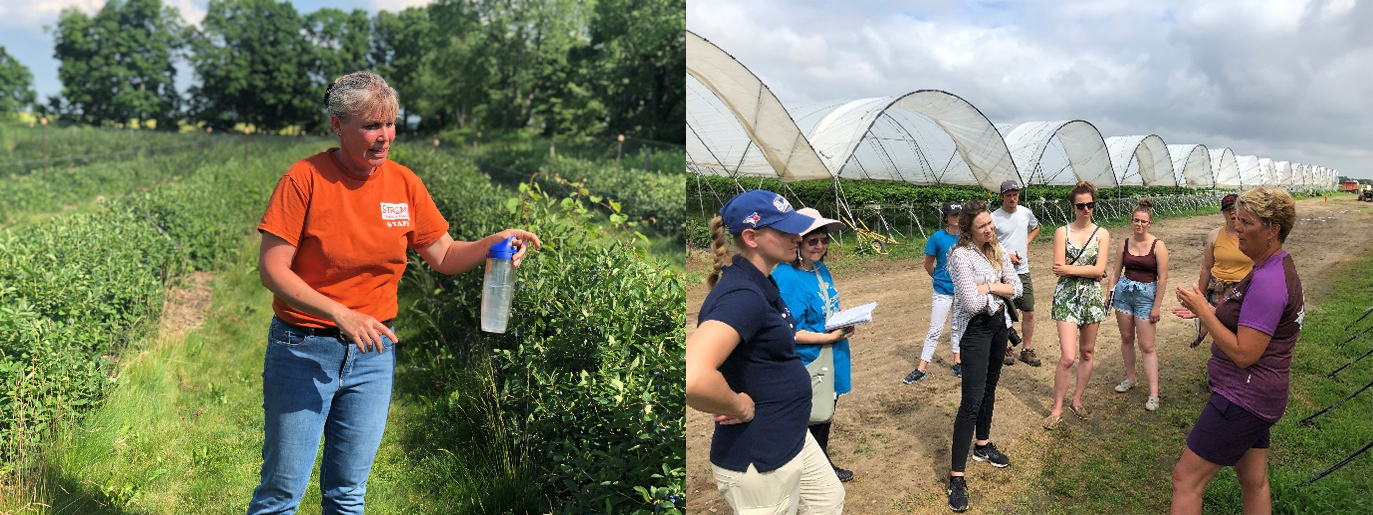
Perennial crops are typically grown as forage or forage seed, which depends on livestock for consumption and clearly links with other 6C strategies of Compost + organic amendments and Crop + animal diversity. Perennial grains (e.g., wheat) and oilseeds (e.g., sunflower) are increasingly being considered as options to increase living cover in cropping systems. Perennial grains may be grown to varying degrees, ranging from permanent cover to being included as a phase in an annual crop rotation (Martens et al., 2015). In Canada, perennial grains are not widely grown, primarily because varieties have not yet been developed for Canadian growing conditions (Cattani and Asselin, 2017). Until breeding programs develop perennial grains and oilseeds suitable to Canadian growing conditions, perennial forage will likely remain as the dominant option for including perennials in Canadian cropping systems.

There are some options to incorporate the concept of continuous living plants into annual systems. In Canada, annual crops may have living roots that grow for 3 to 5 months of the year. Land managers do have a few options to extend that duration, as well as to increase the number and type of living plants growing in soil (Figure 15.19). Growing winter annuals, such as winter wheat or fall rye in a crop rotation allows for living roots to be growing in the fall and early spring. Cover crops grown in the fall and early spring are another option; their benefits and limitations are outlined in more detail in the next section. Increasing crop diversity (described in Crop and Animal Diversity section) by inter-seeding two plant species together through relay cropping or intercropping can also add duration and increase the number and type of living roots in annual crop rotations. Agroforestry is the integration of woody plants such as trees and shrubs into agricultural systems and is another option for perennializing the system. Woody plants may be grown as shelterbelts or in alley cropping where annual crops are grown between rows of woody plants. The inclusion of woody plants to agricultural systems can add additional ecosystem services by increasing plant diversity, habitats for pollinators and other fauna, soil carbon storage, suppression of crop diseases and pests, and regulation of water and nutrient cycles.
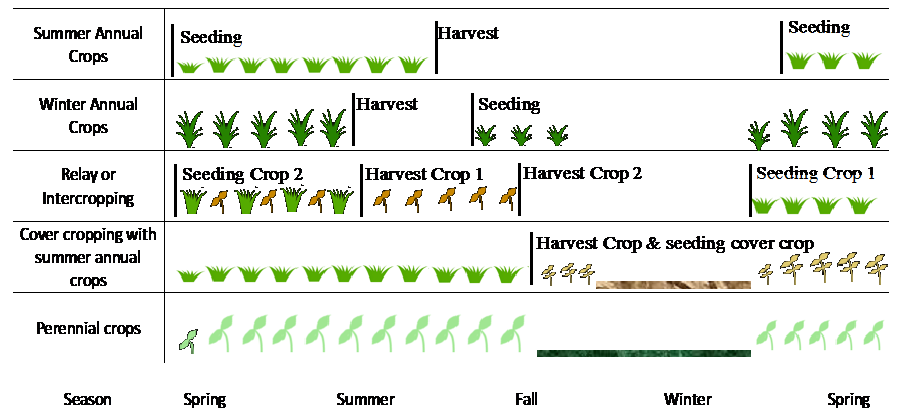
6C–4: Cover crops
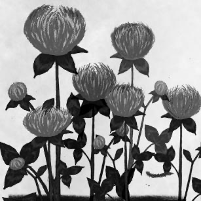 The concept of cover cropping is not new. The use of cover crops dates back to ancient civilizations such as the Roman and Mayan empires, and likely even further back to the dawn of agriculture. Cover crops are plants grown to protect the soil and therefore serve an alternate purpose than growing a crop for its harvestable commercial product (i.e., grain, fruit, fibre, fuel). For this reason, cover crops are sometimes called service crops because of their role in influencing ecosystem services such as erosion control, nutrient supply, climate regulation, water quality and supply, and biodiversity conservation. Cover crops act as a ‘catch crop’, capturing nutrients that would otherwise be lost if not taken up by the main crop. On the other hand, cover crops may supply nutrients to the following main crop if used as green manure (similar to compost or livestock manure). It is important to note that different cover crops do not influence each ecosystem services in the same way. For instance, certain over-wintering legumes alter nitrogen dynamics, but are poor competitors with weeds during establishment. It is therefore important to match the cover crop species to the ecosystem goods and services desired. Here we will build on the concept of soil health developed in the Continuous living plants section, while introducing multiple approaches and challenges associated with cover cropping.
The concept of cover cropping is not new. The use of cover crops dates back to ancient civilizations such as the Roman and Mayan empires, and likely even further back to the dawn of agriculture. Cover crops are plants grown to protect the soil and therefore serve an alternate purpose than growing a crop for its harvestable commercial product (i.e., grain, fruit, fibre, fuel). For this reason, cover crops are sometimes called service crops because of their role in influencing ecosystem services such as erosion control, nutrient supply, climate regulation, water quality and supply, and biodiversity conservation. Cover crops act as a ‘catch crop’, capturing nutrients that would otherwise be lost if not taken up by the main crop. On the other hand, cover crops may supply nutrients to the following main crop if used as green manure (similar to compost or livestock manure). It is important to note that different cover crops do not influence each ecosystem services in the same way. For instance, certain over-wintering legumes alter nitrogen dynamics, but are poor competitors with weeds during establishment. It is therefore important to match the cover crop species to the ecosystem goods and services desired. Here we will build on the concept of soil health developed in the Continuous living plants section, while introducing multiple approaches and challenges associated with cover cropping.
Types of cover crops: Almost any plant can be grown as a cover crop, but certain characteristics—such as rapid emergence and growth as well as relatively inexpensive seed costs—are more desirable. Cover crops are grouped into five general categories based on ecological niche, plant type, and growth form (Table 15.4). Legume cover crops have a stand-alone category due to their ability to fix nitrogen, whereas the other cover crops are categorized based on their warm- or cool-season classification, largely driven by their ability to survive the winter. Whether a warm- or cool-season plant is appropriate to grow depends on the time of year and the climate. To increase diversity, cover crops are often planted as mixtures called bi- or poly-cultures. When making a polyculture or a ‘cover crop cocktail’, a good approach is to mix from these five categories (Table 15.4; Figure 15.20).
Table 15.4. Common cover crop types with key benefits
| Cover crop type | Example species | Key benefits |
|---|---|---|
| Legumes | Red clover | Nitrogen fixation |
| Warm-season (C4) grasses | Sorghum | Abundant biomass and carbon inputs |
| Warm-season broadleaves | Sunflower | Added diversity |
| Cool-season (C3) grasses | Cereal rye | Rapid growth and overwinter survival |
| Cool-season broadleaves | Radish | Rapid growth and deep roots for nutrient scavenging |
Timing matters: In addition to time of year, the decision on what to plant depends on the desired ecosystem service, and the fit into the land management or cropping system. Cover crops can be sown before or after the main crop or during the growing season. Regardless of when the cover crop is sown, there must be sufficient time for growth. A general rule is that cover crops should accumulate approximately 1 Mg ha-1 of aboveground dry biomass to provide ecosystem services, such as those outlined in Table 15.1. A minimum of six weeks is needed for cover crops that rapidly grow (e.g., buckwheat and mustards), but most cover crops will need over two months of growth—this can limit options to growers in cooler and northern climates. Although some practitioners (such as organic growers, orchardists, or small acreage landowners with high value crops) take their fields out of production to plant cover crops, the timing and length of the main crop growing season dictates whether cover crops can be grown before or after the main crop (Figure 15.19). An alternative method to increase the duration of plant growth is by underseeding a cover crop directly under the main crop. For instance, red clover undersown into small grain cereals (Figure 15.18). The clover grows slowly under the grain canopy, and by grain harvest in August, the red clover cover is well established and has the rest of the year to grow (Figure 15.20C). Yet another approach is to take a section of land out of production for a season to gain full benefits of growing cover crops (see Continuous living plants section). For more information on how to incorporate specific cover crops into your system and region, consult resources provided at the end of the chapter.
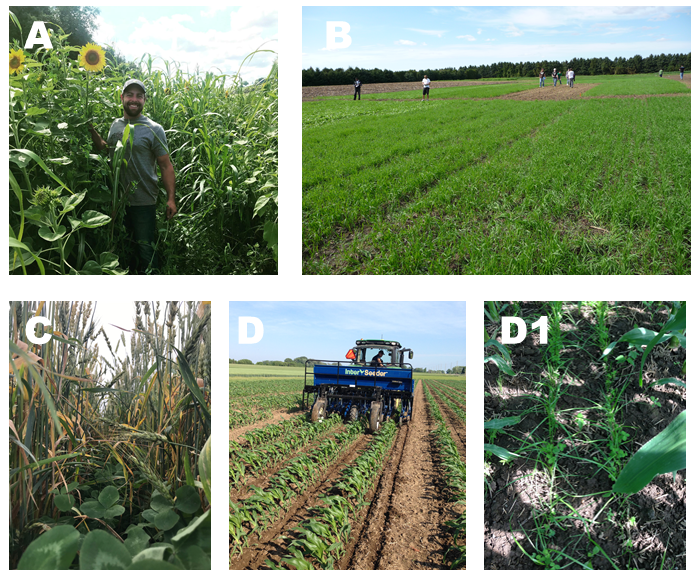
How do cover crops enhance soil health? The importance of plants for soil organic matter (Chapter 3), soil microbial communities (Chapter 6) and soil genesis (Chapter 2) have been outlined. Cover crops are intentionally grown to harness and maximize ecosystem services that plants can provide—and most directly influence soil health. Cover crops enhance soil health by increasing carbon inputs and decreasing carbon exports. Let’s start with the carbon inputs. Cover crops increase primary productivity and thus carbon assimilation and carbon inputs mainly by extending the length of time plants are growing (Figure 15.19). Cover crops are not ‘harvested’; no biomass is removed from the field and therefore no carbon is removed from the field by direct management decisions (except in some systems through livestock grazing; see section on Compost + Organic Amendments and Crop Diversity). The plant material, and carbon contained within, added to the soil enhances microbial activity, and through decomposition a portion is converted into soil organic matter. For example, in Eastern Canada using annual cover crops six times over eight years in a processing vegetable and grain system, aboveground carbon inputs from cover crops were approximately 9 Mg C ha-1, given that 40% of net photosynthetic carbon is allocated belowground, surface soil stored up to 28% more organic carbon than the soils that did not have cover crops growing (Chahal et al., 2020) In this same medium-term cover crop experiment, primary crop productivity was equal to or better with cover crops and soil health tests scores improved by up to 17% compared to the no cover crop control (Figure 15.21; Chahal and Van Eerd, 2018, 2019).
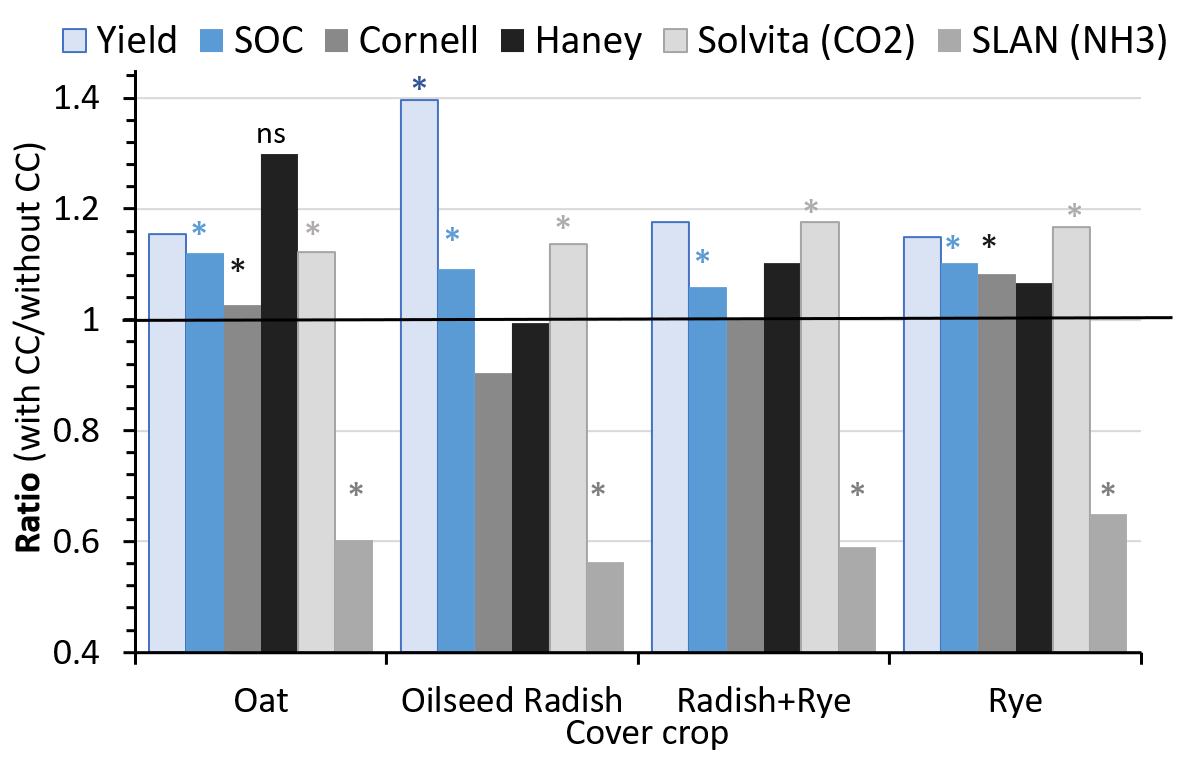
Cover crops not only add carbon through photosynthesis and partial decomposition, but also minimize carbon exports by mitigating erosion and run-off and promoting aggregation. Cover crops act as a physical barrier to the erosive forces of water and wind, which slows water movement and wind speed at the soil surface, thus reducing the force applied and amount of soil and carbon leaving the field. Cover crops can improve soil infiltration, which lowers runoff and water erosion. Cover crops improve soil water storage and supply by acting as a physical barrier to trap snow, which may lead to more soil moisture retention depending on the climate and soil temperatures. Through transpiration, cover crops lower soil moisture thereby increasing the capacity of soil to receive rainfall. Less soil runoff and erosion results in less carbon losses from the field. Carbon losses are also minimized through increased soil aggregation. Because cover crops reduce the amount of time that soils are bare, the plant residues, root exudates, and microbial associations enhances soil aggregation, further protecting carbon inputs against microbial decomposition and carbon loss. An increased amount of stable soil aggregates improves resistance to the physical force of wind and water erosion, and therefore helps maintain soil structure and mitigates surface crusting.
Cover crops enhance other soil health properties, living up to their other name as “service crops”. Cover crops provide additional food and habitats for soil microorganisms and macro-fauna through root exudates and the rhizosphere. As described above, some cover crop roots can penetrate hard plow pan layers, thus ameliorating the negative effects of compaction. While protecting surface soils, cover crops enhance nutrient retention capacity. Deep-rooted cover crops, such as Brassicas (e.g., mustards, radish, turnips), play a key role in moving macro- and micro- nutrients from deeper soil depths to surface and near-surface soil. Specific varieties of mustard species contain high concentrations of glucosinolates that can be managed as a bio-fumigant to suppress soil-borne pests and diseases, particularly in horticultural crops. Translocation of nutrients to near-surface soil along with nitrogen fixation of legumes enhances nutrient availability to the next crop. Through transpiration cover crops lower soil water content, which mitigates leaching losses of nutrients, such as nitrogen to groundwater. Moreover, cover crops increase soil organic matter, which is important for water holding capacity and nutrient cycling. While the aforementioned soil health attributes may be realized by plants in general, the fact that cover crops are in place when fields would otherwise be fallow, greatly extends primary productivity and the capacity to which these benefits can be attained.
The trouble with cover crops: With all the benefits cover crops can provide, why are only 13.7% of Canadian farmers reporting cover crop use (see Figure 15.22)? An obvious barrier is money. Cover crops are grown as ‘service crops’ that are not harvested; therefore, they do not produce a product to sell nor an income to farmers. Likewise, it is very difficult to put a dollar value on the ecosystem services that cover crops provide. Cover cropping has immediate costs (seed, planting, terminating), but expected benefits accrue over the long-term and many of these benefits are realized off-field (e.g., less soil erosion, less nitrogen and phosphorus runoff to surface water) while costs are borne by the farmer.
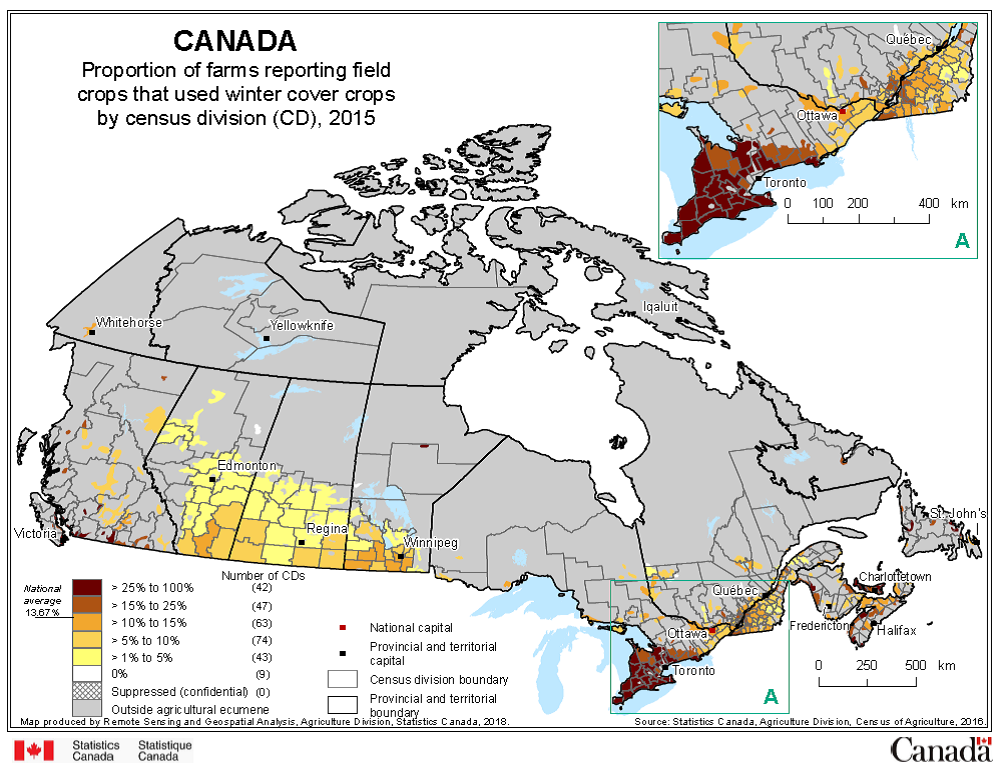
In many climates and cropping systems, there is the very short time period available for cover crops to grow. For many main crops like grain corn or in regions with a shorter growing season, particularly in the Prairies and northern Canada, there just is not a lot of time to grow a cover crop. Growing cover crops are even further challenged in the semi-arid climate of the Prairies because they can reduce soil water content, which limits main crop productivity. Other adverse effects on the main crop as a result of cover crop use include a potential increased incidence of pests in certain crops and hampered nutrient supply. Non-legume cover crops with high biomass and C/N ratios immobilize N, which makes it difficult to estimate adjustments to synthetic fertilizers. Although legume cover crops, such as clovers and alfalfa, provide mineral N to the following crop, there is no clear method to estimate fertilizer reductions.
Adoption of cover crops places greater demands on the grower’s decision making; there is a learning curve and an extra level of management. Cover cropping also demands time and when farm sizes increase, so too do time constraints. For example, in the spring, cover crop residues must be managed and in cold, wet springs, soils with plant residues on the soil surface will not warm up nor dry out quickly, which causes planting delays. Further, it is not unusual to have uneven cover crop stands, which complicates management in the following crop. Despite these limitations, practitioners and researchers are finding innovative methods to overcome these limitations. Indeed, adaptation is on the increase, with national cover crop use increasing 5.5% from 2011 to 2018. Further efforts are needed to mitigate these challenges by developing agronomic solutions that work in Canada, while quantifying the resulting soil ecosystem and services of cover crops.
6C-5: Crop and animal diversity
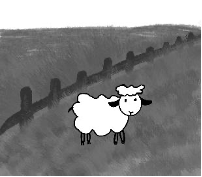 While cover crops increase plant diversity and improve soil health, they are not a substitute for good crop rotation (i.e., main crop diversity). This is because cover crops are present in the soil for a shorter period of time than a main crop. A good crop rotation considers plant diversity temporally and spatially. Canadian organic standards (CAN/CGSB-32.310-2020) extend this concept further, where plant families rather than species must be rotated (i.e., tomatoes and potatoes belong to the same family – Solanaceae). All crops benefit from rotation, with estimates of 10% yield increases over continuous cropping and up to 25% in drought years. This phenomenon is well known in agriculture, such that contracts between growers and the companies buying their commodities typically include a clause stating that the crop should be grown in any particular field only once every four to five years. Similarly, in southwestern Ontario—and although farmers have the land base—processing tomato growers will rent land where Solanaceae plants have never been grown before. The expected yield gain of 12 to 15% (pers. comm. Cory Cowan CCA), derived from less soil-borne pathogens and compaction, more than compensates for the rental and added transportation costs.
While cover crops increase plant diversity and improve soil health, they are not a substitute for good crop rotation (i.e., main crop diversity). This is because cover crops are present in the soil for a shorter period of time than a main crop. A good crop rotation considers plant diversity temporally and spatially. Canadian organic standards (CAN/CGSB-32.310-2020) extend this concept further, where plant families rather than species must be rotated (i.e., tomatoes and potatoes belong to the same family – Solanaceae). All crops benefit from rotation, with estimates of 10% yield increases over continuous cropping and up to 25% in drought years. This phenomenon is well known in agriculture, such that contracts between growers and the companies buying their commodities typically include a clause stating that the crop should be grown in any particular field only once every four to five years. Similarly, in southwestern Ontario—and although farmers have the land base—processing tomato growers will rent land where Solanaceae plants have never been grown before. The expected yield gain of 12 to 15% (pers. comm. Cory Cowan CCA), derived from less soil-borne pathogens and compaction, more than compensates for the rental and added transportation costs.
Although the benefits of avoiding monoculture are well known, the mechanisms that explain why we see increased primary productivity with crop diversity are largely unknown. One obvious benefit is reduced pest pressure in diverse systems, particularly soil-borne pests. Another—but less obvious—contributing factor is enhanced soil health in diverse systems. Diverse systems tend to have higher soil organic matter. Because the same source of carbon inputs is provided in monoculture, the lack of diversity in carbon inputs selects for microbial communities that can decompose the specific source of carbon supplied by that crop (recall Darwin’s natural selection). In more diverse systems there are many different types of carbon inputs, which influences the ability for microbes to use (decompose) carbon sources. Plant diversity likely promotes microbial diversity and functional redundancy. By mimicking nature and including a diversity of plants in any given field (over time and space), there will be a more diverse soil community. The diverse communities lead to more stable populations and confers resiliency to abiotic and biotic stressors. It is important to consider both temporal and spatial diversity—and combination of planting intercrops, cover crops, and perennials helps to address both. We will expand on the previous described 6C strategies and provide examples of how crop diversity enhances soil health.
It’s not just how many you grow, it’s what you grow: To build soil health, it is not enough to have high plant diversity; rather, it is key to grow plants with high carbon inputs and, if possible, avoid soil depleting crops. For example, soybean is considered a soil depleting crop. In the Prairies and elsewhere, many grass species are known for their high carbon inputs, particularly belowground carbon inputs. A diversity of plant species means that there will be diversity in root architecture, rooting depths, carbon composition and root exudates. Maximizing both the aboveground and belowground biomass can help build soil health. Deep-rooted crops include canola, sunflower, safflower, and alfalfa. Extensive root systems increase the rhizosphere volume—providing a ‘bigger buffet table’ for the microbes. The roots and resulting carbon inputs also strengthens the soil structure and aggregation, which improves soil resilience to threats such as erosion, compaction, and crusting.
Winter wheat: the soil builder in Eastern Canada: Based on the long-term tillage systems and crop rotation trials in Southwestern Ontario, rotations that include small grains, such as winter wheat, have 10% greater soil health values based on various soil health tests (Congreves et al., 2015) as well as greater organic carbon (Congreves et al., 2017) and 20% greater water stable aggregates (Figure 15.23; (Van Eerd et al., 2018). Soil health was equivalent to or greater than rotations with winter wheat and a red clover cover crop, as well as with the continuous living cover of alfalfa (Figure 15.18). The increases in organic carbon and soil health conferred by winter wheat resulted in at least 10% yield increases in grain corn and soybeans when winter wheat was in the rotation. Moreover, crop yields were more stable in extreme weather years and required 17% to 22% less fertilizer N with winter wheat in the rotation (Gaudin et al., 2015) and attributed to increased soil health. Thus, winter wheat increases agroecosystem stability and resiliency mediated through improved soil health.
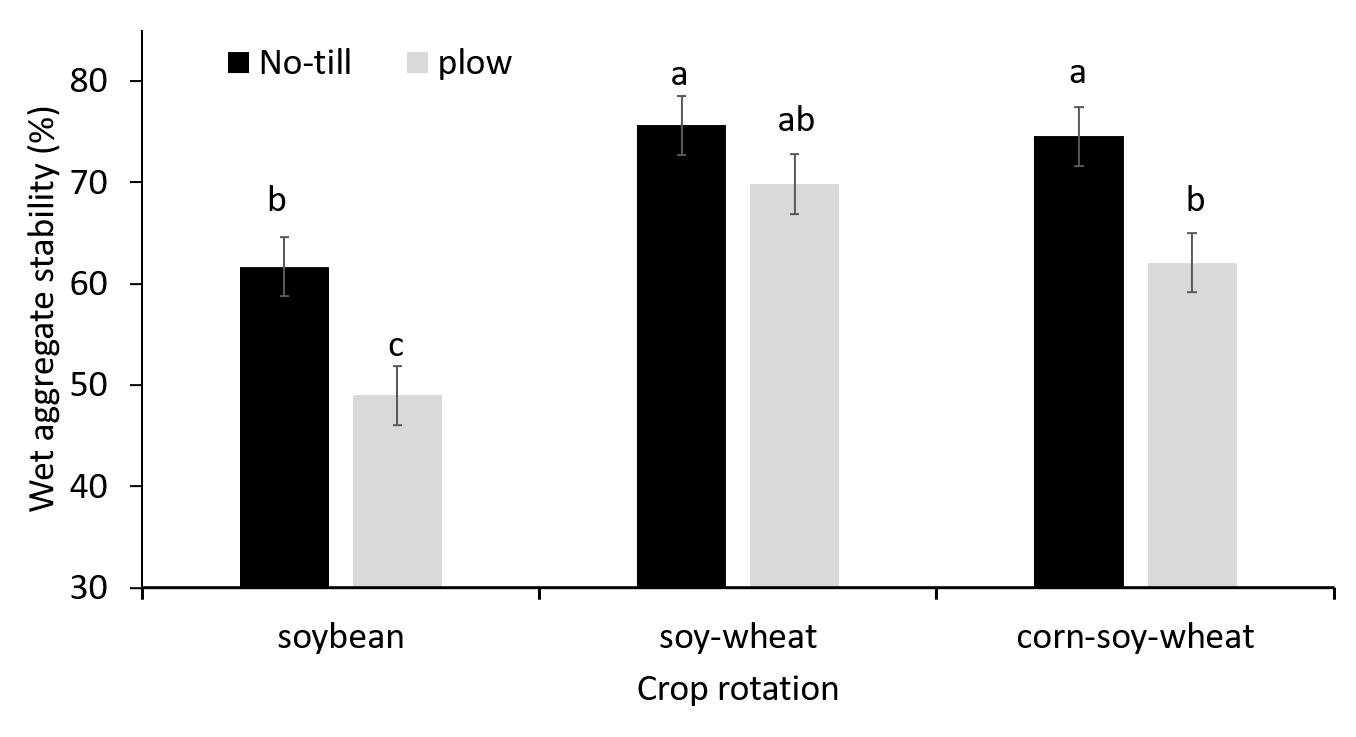
The mechanism by which winter wheat improves soil health is undoubtedly due to greater and diverse carbon inputs as winter wheat is a grass species with an extensive root system. Greater yields for corn and soybean when winter wheat is in the rotation goes hand-in-hand with greater amounts of crop residue returned to the soil (higher yields correspond to larger plants and more carbon). By including winter wheat in the rotation, different carbon compounds are added to the soil at different times of year, as previously mentioned. Winter wheat is planted in September, which provides carbon inputs during a time of year when other rotations would be fallow. Finally, winter wheat provides soil protection during the time of year when erosive forces of wind and water are particularly strong (fall to early spring). Notice the similarities to cover crops and continuous living plants (refer to the previous two sections).
Even more ways to increase crop diversity: In addition to a good crop rotation, growing a mixture of crops can be achieved in a variety of ways. Polyculture and intercropping are techniques where two or more crops are grown simultaneously on the same land, whereas, relay and sequential cropping involves growing two or more crops in the same season (Figure 15.19). An example of this would be intercropping squash into winter wheat. While wheat crop yield is reduced to allow for the squash crop to be planted in early June, there are advantages for squash production. By wheat harvest in July, squash vines are elongating with the added advantage of fruit developing on crop residues as opposed to soil. This system reduces squash soil-borne disease pressure and minimizes labour during harvest as there is less soil to clean off the fruits. On the prairies, chickpeas and flax have shown promise as an intercrop system by using special equipment to separate the grains at harvest. Polycultures are mixtures of plants, planted primarily for ecological benefits. Some farmers use polycultures as a cover crop mix or a forage crop, while others use polycrop strips along field edges to support biological diversity. While critics would cite lost acreage as a negative factor of this planting approach, the beneficial insects that some plants and mixtures encourage helps with pest management.
Not just plants, animals are important too: A diverse system also includes animals. There are positive effects of grazing on primary productivity and increased plant belowground carbon inputs. Moreover, with animals in the system carbon is returned to the soil with feces and manure. This is explored more in the section about Continuous living plants, which are often grazed or used as forage in livestock systems (e.g., alfalfa grown for cattle feed) and in the section on Composts and amendments, which are often plant material that has been partially decomposed or processed through animals.
Challenges: Similar to the other 6C soil sustainable management strategies, the decision to diversify crop rotations is based on many factors. Growing different crops temporally distributes finances and labour because crops are planted and harvested at different times, which may be viewed as an advantage (less of a time crunch at any one time point) or disadvantage (labor needed over a longer time period). Many crops require specialized planting or harvesting equipment, which requires capital investment and routine maintenance. Another important consideration is market access and fluctuating prices. Regardless, in the long run, soil health benefits are expected with diverse systems.
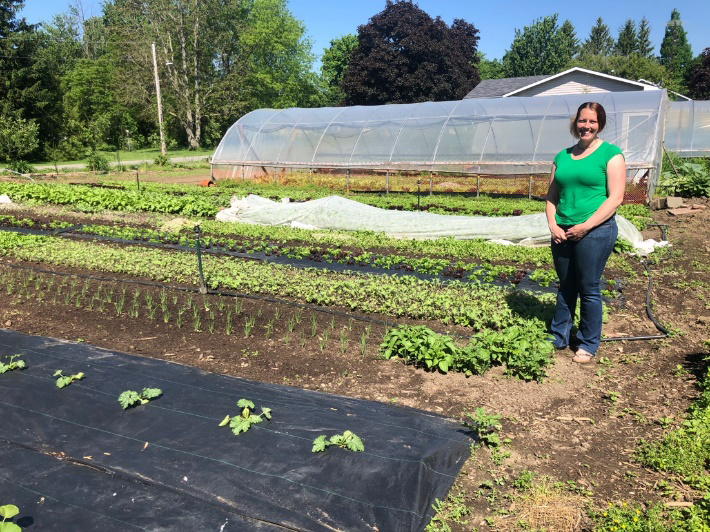
6C–6: Compost and amendments
 Using the simplest definition, an organic soil amendment is any carbon-based material added to the soil. Composts are a type of organic amendment that has been partially decomposed before application. Thus, it is easy to see how applying composts and organic amendments directly applies to the soil health principles of building carbon (Table 15.3). For the most part, the sources of carbon material are largely regarded as ‘waste products’ from various sources such as humans, food, plants, animals (Table 15.5) where soil is viewed as ‘the recipient’ of this waste. It is unfortunate that these valuable carbon sources are viewed as wastes instead of as a critical resource in building soil health. This view really needs to change if real progress in building soil health and soil reclamation is to be made (see Chapter 16) for more information on reclamation). In this section, you will learn about different amendment types, the various mechanisms by which compost and amendments enhance soil health, and the practical challenges or barriers to adopting this practice.
Using the simplest definition, an organic soil amendment is any carbon-based material added to the soil. Composts are a type of organic amendment that has been partially decomposed before application. Thus, it is easy to see how applying composts and organic amendments directly applies to the soil health principles of building carbon (Table 15.3). For the most part, the sources of carbon material are largely regarded as ‘waste products’ from various sources such as humans, food, plants, animals (Table 15.5) where soil is viewed as ‘the recipient’ of this waste. It is unfortunate that these valuable carbon sources are viewed as wastes instead of as a critical resource in building soil health. This view really needs to change if real progress in building soil health and soil reclamation is to be made (see Chapter 16) for more information on reclamation). In this section, you will learn about different amendment types, the various mechanisms by which compost and amendments enhance soil health, and the practical challenges or barriers to adopting this practice.
Table 15.5. Common types of amendments available in Canada
| Amendment | Sources | Phasea | Principle constraint | Reference |
|---|---|---|---|---|
| Generated On-Farm | ||||
| Animal manure | Livestock excrement | S, L, C | Pathogens | Maillard and Angers (2014) |
| Crop residues | Trimmings, culls and wash water | S, L, C | High N | |
| Non-Agricultural Source Materials (NASM) | ||||
| Biosolids | Sewage waste | L, S, P, C | Pathogens | Levesque et al. (2020) |
| Food waste | Processors, Municipalities | All | Salts | |
| Wood waste, yard trimming | Municipalities, Pulp and paper, Forestry products | S, C, U | N and P immobilization | Camberato et al. (2006) |
| Biochar | Pyrolysis | S | High energy input | Mechler et al. (2018) |
| a Dominant but not the only phase of available amendments (not in order). S=solid, L= slurry liquid, C=composted, U=unprocessed, P=processed (e.g., de-watered, pelletized). | ||||
Why bother composting? Organic amendments can be applied directly (e.g., culls after sorting and packaging vegetables on farm) or they can be processed, generally for ease of transport and application. Composting is one common form of processing. Composting is an aerobic process of decomposition mediated by microorganisms that results in stable organic material. It requires management of oxygen concentrations, moisture, temperature and carbon to nitrogen ratios (Figure 15.25); it is not enough to just leave a pile of manure in place over time. As materials decompose and carbon dioxide evolves, odor is minimized, pathogen loads are reduced (requires high temperatures), water is evaporated or leached, and the total volume of materials is reduced by approximately 50% which concentrates nutrients. For most practitioners, pathogen and volume reductions are the main reasons for composting. Because the most readily available materials are decomposed first, the remaining material (i.e., compost) is relatively stable. Nutrients are mainly in their organic form as opposed to mineral form, and thus are not as readily available (recall Chapter 7 Nutrient Cycling). From a crop management perspective, nutrient availability from composted manure is typically greater in years 2 and 3 than the year of application; hence, timing of application relative to crop nutrient uptake is important.
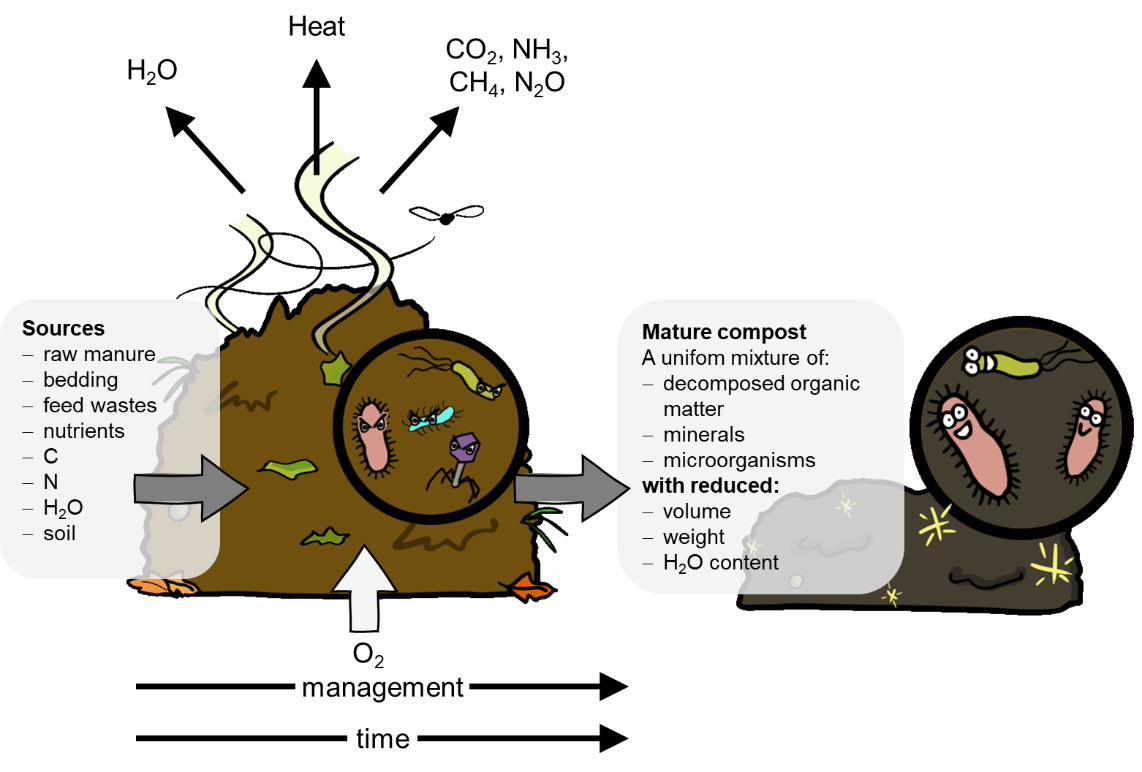
How do organic amendments enhance soil health? Similar to the other ‘Cs’ of soil health, organic amendments improve soil health through a number of mechanisms. Likely the most obvious and influential is increases in building soil carbon, which enhances soil infiltration, water holding capacity, microbial activity, CEC, nutrient availability. Physical improvements to soil health are expected due to the complex nature of the organic materials in the amendment. For instance, biosolids used in a semiarid grassland in British Columbia, increased soil aggregate size and stability, due to higher concentrations of carbon and nitrogen in aggregates (Wallace et al., 2009). The surface application of organic amendments also improves the availability of water and nutrients, and promotes plant growth, which in turn increases soil carbon (see continuous living plants). Meta-analyses (i.e., big data) showed that the quantity of carbon applied over time was positively related to soil organic carbon content (Maillard and Angers, 2014) and that amendments had a improved soil health of various biological, chemical and physical soil attributes (Norris and Congreves, 2018) (Figure 15.26). In fact, positive effects of organic amendments on soil health and crop productivity can be long-lasting (decades) and mitigates the negative effects of erosion (Larney and Olson, 2018).
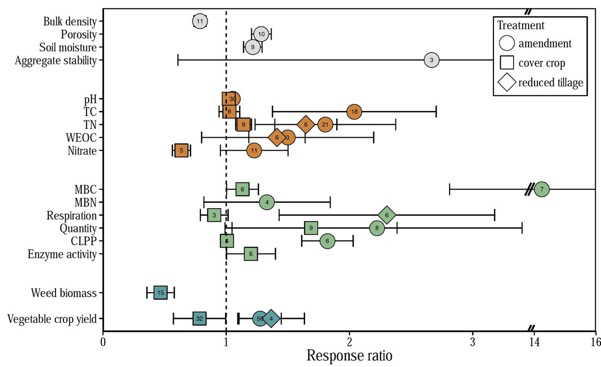
Organic amendments alter soil microbial communities and depending on the degree of decomposition may stimulate microbial activity in soils. For example, biochar has been found to favor the establishment of plant beneficial bacteria and increased bacterial richness in a greenhouse study in Quebec, Canada (Lévesque et al., 2020). Likely, this occurred through increases in ecological micro-niches and nutrient availability in the peat-based growing medium. In New Brunswick, applications of organic amendment effectively suppressed soilborne potato diseases in potato fields. In these fields, the level of disease suppression was linked to the quantity of carbon in compost, rather than its quality (e.g., C/N ratio, degree of decomposition) (Wilson et al., 2018). Similarly, in Ontario processing tomato fields with a soil-borne disease complex, crop yields improved with organic amendment application, which was attributed to changes in the rhizosphere and root colonized microorganisms (Van Eerd et al., 2021 – unpublished data). Thus, while it is generally accepted that organic amendments influence soil microbial communities, there is evidence that it might also be beneficial in disease suppression.
In addition to amount of carbon applied, many other factors also impact an amendment’s effect on soil health, including climate, vegetation type, soil pH, soil microbial community, etc. Site-specific applications of amendments may be beneficial. In their review of amendments, Larney and Angers (2012) suggest that degraded soils have the greatest potential to benefit from composts and organic amendments in terms of soil health and primary productivity. Thus, there is an opportunity for site-specific application to degraded areas within a field (such as sandy knolls or compacted areas) (Figure 15.27A).

Choices, choices, choices: With so many amendments sources available (Table 15.5) and with so many different materials within each type of amendment (e.g., liquid, slurry, solid), the options are seemingly endless. The decision on what to apply depends on both soil conditions and the amendment composition, which largely centre around nutrient, salt and heavy metal concentration and pH. Application rates can be based on carbon or organic matter content, but are often made based on nutrient levels (particularly N, P). The decision on which amendment to apply depends on over-coming the challenges listed below as well as availability and, of course, costs.
Challenges: As with any management decision, there are trade-offs to consider when using organic amendments. Amendments, particularly of animal or human origin, contain pathogens. Although composting minimizes pathogen load, management must minimize pathogens in the crop and in the environment. Provincial rules and regulations regarding method and timing of manure and biosolid applications are designed to minimize the risk of pathogen and nutrient movement off field and to reduce odor. For instance, the timing of application to soil is often restricted to times of year when crops are not being grown (i.e., spring or fall). In many regions, soils are wet during the spring and late fall, so the application of amendments may lead to soil compaction. Soil compaction is exacerbated as organic amendments are bulky and requires specialized, heavy application equipment. Moreover, in order to minimize odor and surface nutrient losses, tillage may be required to incorporate the amendment. (recall Compaction reduction and Conservation tillage effects).
Although a significant quantity of organic amendment is necessary to observe enhancements in soil health, certain nutrients (e.g., P, K) and heavy metals (particularly Zn) accumulate in soil. Excessive levels can pose a risk to human, animal and environmental health. Likewise, some amendments are high in salts, which can burn plants and may create salinity problems in semi-arid climates. Finally, while the costs and nutrient benefits are immediate, the soil health benefits from amendments typically accumulate over time and following repeated applications. This is a challenge for cash-strapped landowners, however, long-term investments in soil health are expected to result in increased primary productivity and system resiliency, which is not unlike the other 6C soil health management strategies.
Other sustainable soil management approaches
In addition to the 6C strategies, there are other approaches that can be done to improve soil health (Table 15.6). These practices can occur in the field or around the field perimeter. Many are targeted to problem areas of a field and not all are applicable. As with the 6Cs, holistic considerations should be made when deciding to adopt any of these approaches.
Table 15.6. Additional approaches that can be used to help achieve soil health
| Approach | Example | Soil Health Principle | ||||
|---|---|---|---|---|---|---|
| Protect Soil | Diversity + Perennialization |
Build Carbon | ||||
| Maximize soil cover | Minimize soil disturbance | Enhance C inputs & gains | Minimize C & soil loss | |||
| Windbreaks | Tree barrier around field | ♥ | ∗ | ⊕ | ||
| Water erosion control structures | Vegetative strip where water flows | ♥ | ⊕ | ∗ | ||
| Land retirement | Convert to natural ecosystem | ∗ | ♥ | ⊕ | ||
| Riparian zones | Vegetative strip before bodies of water | ∗ | ⊕ | ∗ | ||
| Physical remediation | Move soil from depositional sites (e.g. low areas or ditches)to eroded positions in landscape | ⊕ | ∗ | |||
| Contouring | Shaping land and growing crops perpendicular to slope | ⊕ | ∗ | |||
| Subsurface drainage | Move water off field quicker; compaction less likely | ⊕ | ⊕ | |||
| ♥ principle goal and benefit; ∗ expected benefit; ⊕ likely benefit | ||||||
SUMMARY
Soil health is an important concept because it requires us to consider soil as a living system integrating biological, chemical, and physical properties. We can measure soil health and compare using visual soil assessments, soil health tests, or using integrated scores calculated from multiple soil health indicators. Through the ability of soil to function and provide ecological services, soil health connects people and their management decisions with soil, plants and animals.
Individual management practices influencing soil health can be categorized using the 6C framework: Compaction reduction, Conservation tillage, Continuous living plants, Cover crops, Crop and animal diversity, and Compost & amendments. Each of these management strategies has benefits and challenges. The 6C practices can be implemented individually or, ideally, in combination. As you probably noticed, there are a lot of connection between the 6C’s. For example, using cover crops will increase the duration of continuous living plants and adds crop diversity. The timeline for measuring responses to new soil health management practices range from years to decades depending on the management practice, soil characteristics, cropping system, and local environment. But adopting any of the 6Cs will have a positive impact.
It is an exciting time to be learning about soil health. When talking with farmers, agronomists, conservationist, and gardeners about soil health we often hear from them “I wish that I had learned this when I was in school/university.” We are confident that soil health will be on your mind when your life next intersects with soil. Soil science is continually breaking new ground. Our knowledge about soil health and the tools we have to characterize it are poised to increase exponentially during your lifetime. We invite you to continue learning about soil and join us to make these new discoveries.
SUGGESTED READING
Best Management Practices SOIL HEALTH http://www.omafra.gov.on.ca/english/environment/bmp/AF151.pdf
Magdoff and Van Es. 2009. Building Soils For Better Crops. Sustainable Soil Management. Third Edition. Sustainable Agriculture Research and Education (SARE). ISBN 978-1-888626-13-1 https://www.sare.org/Learning-Center/Books/Building-Soils-for-Better-Crops-3rd-Edition/Text-Version
ADDITIONAL RESOURCES
Infographic What is Soil Health by SARE outlines sustainable management practices. https://www.sare.org/Learning-Center/What-is-Soil-Health
Eastern Canada cover crop decision tool or MCCC cover crop selector tool
http://www.omafra.gov.on.ca/english/environment/bmp/soil-health.htm
https://www150.statcan.gc.ca/n1/pub/95-634-x/2017001/article/54903-eng.htm
Managing Cover Crops Profitably. Third Edition. Ed. A Clark. Sustainable Agriculture Research and Education (SARE)
https://www.sare.org/Learning-Center/Books/Managing-Cover-Crops-Profitably-3rd-Edition
NRCS Soil quality test kit. http://www.nrcs.usda.gov/wps/portal/nrcs/detailfull/soils/health/assessment/?cid=nrcs142p2_053873
STUDY QUESTIONS
- Soil health tests currently available are weighted (or less commonly unweighted) averages of numerous soil indicators; where greater values indicate better soil health. This approach works well, but one criticism is that a soil could have a high test score but not support plant growth (i.e., doesn’t support primary productivity and thereby by definition is not a healthy soil). For instance, a soil with pH < 5.2 limits plant growth but all other soil indicators may be ok. Your task is to find a solution. How could this be a handled in a soil health index?
- Using Table 2 and what you have learned from the other chapters (particularly Chapters 3-7), identify what is missing from the list. Why do you think it isn’t included?
- Compare and contrast approaches to enhance soil health with approaches outlined in Soil Reclamation chaper of this textbook.
- Pick two of the 6C strategies of soil health management. Compare and contrast how these approaches enhance soil health.
- In science, there are always exceptions to the rule. There are situations where crop diversity would not be expected to enhance soil health. Provide two examples with different mechanisms and explain.
- What are the different methods of incorporating cover crops into crop rotations? Pick one system and state advantages and disadvantages of incorporating cover crops.
- What are three universal limitations to adopting the 6C practices of soil health management?
ONE MINUTE PAPERS
- Choose one of the 6Cs. Describe how there are gains in soil organic carbon or how losses are minimized with the practice you selected.
- You just purchased a brand new house (congratulations!) in a brand new neighbourhood (yikes- soil was degraded during building). You want to do the landscaping and know soil is important for successful plant growth. Describe how would you assess your soil and what you would look for to protect your investment in plants ensure they will thrive? Which 6C practices of soil health management would you use to improve the expected poor soil condition left by the builders?
OUTDOOR ACTIVITIES
- SOIL YOUR UNDIES: Bury all-cotton underwear so that the waistband is at or near the soil surface. You want to maximize soil to cotton contact, so spread it out. Be sure to mark the area with a flag so that you can dig up the underwear 2 to 3 months later. Keep in mind that soil temperature and moisture influence soil activity, so you may want to adjust the length of time it is buried. Compare two different soils. Make a hypothesis: which soil do you think is the healthiest, most active? What does the amount of cotton remaining tell you about the soil. Was your prediction correct? Why or why not? For more information visit https://www.ifao.com/ and watch these videos https://www.youtube.com/watch?v=Ym0naU1oQmY [https://www.youtube.com/watch?v=akMT1ZZQ8PA]
- MEASURING SOIL COVERAGE: This activity can be done almost anywhere – a field, a lawn, a disturbed forest. Stretch a measuring tape 25 meters. Every 50 cm, count when there is exposed soil as opposed to plant residue or debris. To be counted, the plant residue should be at least the size of a match (4 mm x 45 mm). Times the number by 2 and you have the percent of residue cover. Repeat 3 to 5 times in representative areas of the field to get an average value. To mitigate erosion, 30% coverage is recommended. A rope marked with electrical tape every 50 cm works well too.
- SOIL COMPACTION CAMPUS WALK: Finding signs of soil compaction is not difficult, just take a walk around campus and look for green spaces where students are cutting through to get to class on time. Take a look at the appearance of the soil in the area where students walk compared to the rest of the green space. Think about what has happened to the number and size of pores in these two soils (Photo 17.3). Observe the number of grass plants growing in the area where students walk compared to the rest of the green space. Do you see other “weedy” plants growing where the grass is not? How have these plants adapted to grow where the grass is not? What management would you recommend to improve soil health in this area?
- DESIGNER SOIL HEALTH TEST: Create your own soil health score card Using Table 17.2 and this web guide, create your own soil health test. Identify which variables you will include and why. Will all indicators be weighed the same? If not, why did you weight some indicators more than others? https://www.nrcs.usda.gov/Internet/FSE_DOCUMENTS/nrcs142p2_051879.pdf ANSWER: with justification, test must include chemical, physical and biological indicators and must include a measure of carbon quantity or cycling. LO#1-3:
- COMPOSTING AT HOME: Now that you’ve learnt about the process and benefits of composting, why not start composting at home! In your backyard (or community garden), start composting your food and yard wastes. You can easily make your own compost bin! Add compost materials in layers, maintaining a balance between “green” materials (e.g., almost anything from your kitchen, fresh-cut lawn) and “brown” waste (e.g., dead leaves, old newspapers, etc.). Make sure to provide oxygen to your compost by mixing it well regularly (weekly or biweekly). Keep compost moist (but not too moist!). Take a handful of your compost and look at it. If you press it, is water running from it (i.e., too wet)? Any odor?
DIGITAL ACTIVITIES
- SOIL HEALTH from a FARMER’s PERSPECTIVE: Watch Farmer Fred Kirschenmann’s TEDx Talk on Soil –from dirt to lifeline. Discuss the current constraints on farmers and farm systems. Although he doesn’t explicitly say 6Cs, discuss how adopting the 6C practices of soil health management can provide various benefits and identify the benefactors.
- DECISION TOOL: Use either the Eastern Canada or the Midwest cover crop decision tool to answer the questions for this case study. You own a CSA (Community Supported Agriculture) where you grow over 15 different vegetables. You purchased new land in August. This ground was tilled aggressively, often when the soil was too wet, and appears to have resistant weeds. You are planning on planting a cover crop in August with the goal of improving soil and crop productivity.
- Based on the farm details, select three goals you would want your cover crops to achieve and explain why. ANSWER: goals compaction reduction, weed fighter, organic matter builder, perhaps another goal if well explained.
- Based on the high ratings of these covers for the goals you selected, choose two cover crops you might want to grow. Based on the two cover crops you picked, look at the advantages and disadvantages in the info-sheets and choose the best cover crop option. State 2 reasons why you picked this cover crop. Give 2 reasons why you didn’t pick the other cover crop. ANSWER: The cover crops should be rated 3 or 4 (out of 4) for the goals selected with reasonable explanations for selecting one cover over the other.
REFERENCES
Andrews, S.S., D.L. Karlen, and J.P. Mitchell. 2001. A comparison of soil quality indexing methods for vegetable production systems in Northern California. Agriculture, Ecosystems and Environment 1760: 1-21.
Bünemann, E.K., Bongiorno, G., Bai, Z., Creamer, R.E., De Deyn, G., de Goede, R., Fleskens, L., Geissen, V., Kuyper, T.W., Mäder, P., Pulleman, M., Sukkel, W., van Groenigen, J.W., and Brussaard, L. 2018. Soil quality – A critical review. Soil Biol. Biochem. 120: 105–125. Pergamon. doi:10.1016/J.SOILBIO.2018.01.030.
Camberato, J.J., Gagnon, B., Angers, D.A., Chantigny, M.H., and Pan, W.L. 2006. Pulp and paper mill by-products as soil amendments and plant nutrient sources. Can. J. Soil Sci. 86: 641–653. NRC Research Press Ottawa, Canada . doi:10.4141/S05-120.
Cattani, D.J., and Asselin, S.R., 2017. Extending the growing season: Forage seed production and perennial grains. Can. J. Plant Sci. 98: 235–246. doi.org/10.1139/cjps-2017-0212
Chahal, I., and Van Eerd, L.L. 2018. Evaluation of commercial soil health tests using a medium-term cover crop experiment in a humid, temperate climate. Plant Soil 427: 351–367. Springer International Publishing. doi:10.1007/s11104-018-3653-2.
Chahal, I., and Van Eerd, L.L. 2019. Quantifying soil quality in a horticultural-cover cropping system. Geoderma 352: 38–48. Elsevier. doi:10.1016/J.GEODERMA.2019.05.039.
Chahal, I., Hooker, D.C., Deen, B., Janovicek, K., and Van Eerd, L.L. 2021. Long-term effects of crop rotation, tillage, and fertilizer nitrogen on soil health indicators and crop productivity in a temperate climate. Soil Tillage Res. 213, 105121. https://doi.org/10.1016/j.still.2021.105121
Chahal, I., Vyn, R.J., Mayers, D., and Van Eerd, L.L. 2020. Cumulative impact of cover crops on soil carbon sequestration and profitability in a temperate humid climate. Sci. Rep. 10:13381| https://doi.org/10.1038/s41598-020-70224-6.
Chen, G., and Weil, R.R. 2010. Penetration of cover crop roots through compacted soils. Plant Soil 331: 31–43. Springer. doi:10.1007/s11104-009-0223-7.
Congreves, K.A., Hayes, A., Verhallen, E.A., and Van Eerd, L.L. 2015. Long-term impact of tillage and crop rotation on soil health at four temperate agroecosystems. Soil Tillage Res. 152. doi:10.1016/j.still.2015.03.012.
Congreves, K.A., Hooker, D.C., Hayes, A., Verhallen, E.A., and Van Eerd, L.L. 2017. Interaction of long-term nitrogen fertilizer application, crop rotation, and tillage system on soil carbon and nitrogen dynamics. Plant Soil 410: 113–127. doi:10.1007/s11104-016-2986-y.
Cresswell, H., and Kirkegaard, J. 1995. Subsoil amelioration by plant-roots-the process and the evidence. Soil Res. 33: 221–239. [Online] Available: http://www.publish.csiro.au/sr/SR9950221.
Doran, J.W., Sarrantonio, M., and Liebig, M.A. 1996. Soil Health and Sustainability. Adv. Agron. 56: 1–54. doi:10.1016/S0065-2113(08)60178-9.
Fox, C.A., Tarnocai, C., Broll, G., Joschko, M., Kroetsch, D., and Kenney, E. 2014. Enhanced A Horizon Framework and Field Form for detailed field scale monitoring of dynamic soil properties. Canadian Journal of Soil Science 94: 189-208.
Gaudin, Tolhurst, T.., Ker, A.P., Janovicek, K., Tortora, C., Martin, R.C., and Deen, W. 2015. Increasing crop diversity mitigates weather variations and improves yield stability. PLoS One 10: e0113261. doi:10.1371/journal.pone.0113261.
Halde, C., Bamford, K.C., and Entz, M.H. 2015. Crop agronomic performance under a six-year continuous organic no-till system and other tilled and conventionally-managed systems in the northern Great Plains of Canada. Agric. Ecosyst. Environ. 213: 121–130. Elsevier. doi:10.1016/J.AGEE.2015.07.029.
Halde, C., Gagné, S., Charles, A., and Lawley, Y. 2017. Organic No-Till Systems in Eastern Canada: A Review. Agriculture 7: 36. Multidisciplinary Digital Publishing Institute. doi:10.3390/agriculture7040036.
Haney, R. L. , Haney, E. B. , Hossner, L. R. and Arnold, J. G. 2010. ‘Modifications to the New Soil Extractant H3A-1: A Multinutrient Extractant’, Communications in Soil Science and Plant Analysis, 41: 12, 1513-1523.
Idowu, O.J., Van Es, H.M., Abawi, G.S., Wolfe, D.W., Schindelbeck, R.R., Moebius-Clune, B.N., Gugino, B.K. 2009. Use of an integrative soil health test for evaluation of soil management impacts. Renew. Agri. Food Syst. 24, 214-224.
Janzen, H.H. 2001. Soil science on the Canadian prairies – Peering into the future from a century ago. Can. J. Soil Sci. 81: 489–503. NRC Research Press Ottawa, Canada . doi:10.4141/S00-054.
King, A.E., Congreves, K.A., Deen, B., Dunfield, K.E., Voroney, R.P., and Wagner-Riddle, C. 2019. Quantifying the relationships between soil fraction mass, fraction carbon, and total soil carbon to assess mechanisms of physical protection. Soil Biol. Biochem. 135: 95–107. Pergamon. doi:10.1016/J.SOILBIO.2019.04.019.
Larney, F.J., and Angers, D.A. 2012. The role of organic amendments in soil reclamation: A review. Can. J. Soil Sci. 92: 19–38. Agricultural Institute of Canada . doi:10.4141/cjss2010-064.
Larney, F.J., and Olson, A.F. 2018. Wheat yield and soil properties reveal legacy effects of artificial erosion and amendments on a dryland Dark Brown Chernozem. Can. J. Soil Sci. 98: 663–677. Canadian Science Publishing65 Auriga Drive, Suite 203, Ottawa, ON K2E 7W6. doi:10.1139/cjss-2018-0025.
Lévesque, V., Jeanne, T., Dorais, M., Ziadi, N., Hogue, R., and Antoun, H. 2020. Biochars improve tomato and sweet pepper performance and shift bacterial composition in a peat-based growing medium. Appl. Soil Ecol. 153: 103579. Elsevier. doi:10.1016/J.APSOIL.2020.103579.
Maillard, É., and Angers, D.A. 2014. Animal manure application and soil organic carbon stocks: a meta-analysis. Glob. Chang. Biol. 20: 666–679. John Wiley & Sons, Ltd. doi:10.1111/gcb.12438.
Mechler, M.A.A., Jiang, R.W., Silverthorn, T.K., and Oelbermann, M. 2018. Impact of biochar on soil characteristics and temporal greenhouse gas emissions: A field study from southern Canada. Biomass and Bioenergy 118: 154–162. Pergamon. doi:10.1016/J.BIOMBIOE.2018.08.019.
Moebius-Clune, B., Moebius-Clune, D.J., Gugino, B., Idowu, O., Schindelbeck, R., Ristow, A., van Es, H., Thies, J., Shayler, H.A., McBride, M.B., Wolfe, D., and Abawi, G. 2016. Comprehensive Assessment of Soil Health The Cornell Framework Manual. 3rd edition. Cornell University, Ithica, New York. [Online] Available: http://www.scs.cals.cornell.edu [2016 Nov. 7].
Norris, CE, Bean, GM, Cappellazzi, SB, Cope, M, Greub, KLH, Liptzin, D, Rieke, EL, Tracy, PW, Morgan, CLS, Honeycutt, CW. 2020. Introducing the North American project to evaluate soil health measurements. Agronomy Journal. 112: 3195– 3215. https://doi.org/10.1002/agj2.20234.
Norris, C.E., and Congreves, K.A. 2018. Alternative Management Practices Improve Soil Health Indices in Intensive Vegetable Cropping Systems: A Review. Front. Environ. Sci. 6: XXX. Frontiers. doi:10.3389/fenvs.2018.00050.
Ogle, S.M., Alsaker, C., Baldock, J., Bernoux, M., Breidt, F.J., McConkey, B., Regina, K., and Vazquez-Amabile, G.G. 2019. Climate and Soil Characteristics Determine Where No-Till Management Can Store Carbon in Soils and Mitigate Greenhouse Gas Emissions. Sci. Rep. 9: 11665. Nature Publishing Group. doi:10.1038/s41598-019-47861-7.
Reicosky, D.C. 2015. Conservation tillage is not conservation agriculture. J. Soil Water Conserv. 70: 103A-108A. Soil and Water Conservation Society. doi:10.2489/jswc.70.5.103A.
Sarrantonio, M., J.W. Doran, M.A. Liebig, and J.J. Halvorson. 1996. On-farm assessment of soil quality and health. p.83-106. In: J.W. Doran and A.J. Jones (eds.) Methods for assessing soil quality. SSSA Spec. Publ. 49.
Savage, C.S. 2011. Prairie : A Natural History. Greystone Books.
Statistics Canada. Tillage practices used to prepare land for seeding (Table 32-10-0408-01) https://doi.org/10.25318/3210040801-eng https://www150.statcan.gc.ca/n1/pub/95-634-x/2017001/article/54903/catm-ctra-390-eng.htm
Thiessen Martens, J.R., Entz, M.H., and Wonneck, M.D., 2015. Review: Redesigning Canadian prairie cropping systems for profitability, sustainability, and resilience. Can. J. Plant Sci. 95, 1049–1072. doi.org/10.4141/CJPS-2014-173
Van Eerd, L.L., DeBruyn, A.H., Ouellette, L., Hooker, D.C., and Robinson, D.E. 2018. Quantitative and qualitative comparison of three wet aggregate stability methods using a long-term tillage system and crop rotation experiment. Can. J. Soil Sci. 98: 738–742. doi:10.1139/cjss-2018-0101.
Van Eerd, L.L., Y. Zhou, A.L. Turnbull, D.M. Johnston-Monje, G. Lazarovitz, S.A. Loewen. (n.d.). Managing tomato vine decline with soil amendments and transplant treatments: Elucidating impact on fruit yield, quality, and plant-associated microbial communities. Canadian Journal of Plant Science. (In revision: August 10, 2021)
Wallace, B.M., Krzic, M., Forge, T.A., Broersma, K., and Newman, R.F. 2009. Biosolids increase soil aggregation and protection of soil carbon five years after application on a crested wheatgrass pasture. J. Environ. Qual. 38: 291–8. J Environ Qual. doi:10.2134/jeq2007.0608.
Wilson, C., Zebarth, B.J., Goyer, C., and Burton, D.L. 2018. Effect of Diverse Compost Products on Soilborne Diseases of Potato. Compost Sci. Util. 26: 156–164. Taylor & Francis. doi:10.1080/1065657X.2018.1432430.
About the Authors
Laura L. Van Eerd, Professor, School of Environmental Sciences University of Guelph Ridgetown Campus
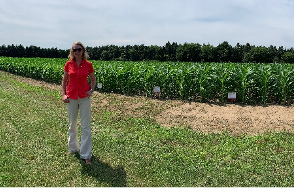
The goal of my research program is to enhance knowledge of nitrogen and carbon cycling in agricultural systems. I have published over 50 peer-reviewed papers (including 2018 Best Paper of the Year in the Canadian Journal of Plant Science), supervised over 20 graduate students and received the Pitblado Teaching Excellence Award. My research has contributed to key policy documents on soil health and cover crops. As recognition of my impact, I was named one of six Influential Women of Canadian Agriculture in 2020.
What kind of work do you do? As a Professor of Sustainable Soil Management, my research program focuses on understanding how the various practices that farmers employ impacts their soil and crop. Thus, my research bridges agronomy and soil science. I am excited to be a co-executive director of Soils AT Guelph, an initiative to promote soil health knowledge by bringing researchers and farmers together. As Research Program Director for the Ontario Agri-Food Innovation Alliance, I lead the Soil and Water Stewardship theme by reviewing and awarding research projects valuing over $1M annually. I have a very rewarding career where everyday can be different; from teaching to research to extension service.
What did you like to do when you were a kid? As a farm kid, my favourite thing to do was explore outside. It’s likely why I’m a scientist today. My younger sister and I would love playing in the fields, making mud pies, digging for earthworms, or breaking up soil crusts. Remember marveling at the odd patterns of curled up soil that resulted when a wet area finally dried. It fascinated me how the same soil could be so different; light and fluffy after tillage, spongy after a rain but later in the season have giant cracks when it was dry. Just thinking about it brings me back to the field behind the house on the home farm.
Kate A. Congreves, Assistant Professor, Department of Plant Sciences University of Saskatchewan
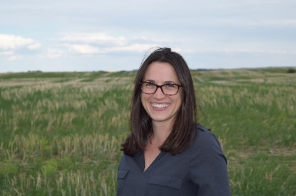
I am an Assistant Professor in the Department of Plant Sciences at the University of Saskatchewan. I grew up on a small farm in Ontario and went on to obtain a B.Sc. in Biology and a B.Ed. from Queen’s University, then PhD in Land Resource Science from the University of Guelph. I specialize in Environmental Agronomy, and focus on nutrient cycling and crop nutrient use, soil health, and greenhouse gas emissions in agroecosystems. My research program is to understand the mechanisms that regulate nutrient and carbon transformations, and the implications for soil ecosystem services.
What kind of work do you do? As a Professor of Environmental Agronomy, I research farming practices that enhance food production in an environmentally friendly way. I design experiments and measure nutrient cycling, soil health, and greenhouse gas emissions with the goal of understanding regenerative agriculture. I am grateful that my profession takes place in various settings: in the field, in the lab, in the classroom, and in the office—that come together to bring meaning in the form of student development, discovery, collaboration, and impact on the industry and environment.
How did you get interested in soil science? My interest in soil science traces back to my early years, when as a child I would garden with my mom. We would plant almost every vegetable I can think of—and tend to them all summer. I remember creating networks of pathways in the soil between the plant rows, where my brother and I would drive our dinky cars and Tonka trucks. Soil was a big part of our game! We would move it around, push it up against the plant roots, haul away the weeds, and hunt for earthworms which always showed up after the rain. Sometimes we would expand our tracks to the compost pile out back, where our pumpkins seemed to grow more voraciously than anywhere else. Immersed in that garden was where I started to think about the soil, consider different aspects of plants, and to appreciate the environment. I am grateful for that experience and to be able to carry it into my career today.
Melissa M. Arcand, Assistant Professor, Department of Soil Science University of Saskatchewan
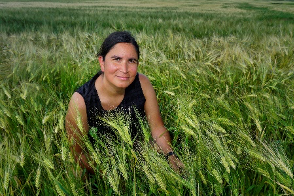
I am a soil biogeochemist with research interests focused on nutrient cycling, carbon storage, and soil health in agroecosystems. I grew up on a farm on the Muskeg Lake Cree Nation in central Saskatchewan, Treaty 6 Territory, and received my PhD in Soil Science from the University of Saskatchewan where I now do research and teach. I am the academic advisor for students in the Kanawayihetaytan Askiy program, designed to train students to work in resource management and land governance in Indigenous communities across Canada.
What kind of work do you do? I get to do exciting research and participate in teaching students soil science, but I also get to work closely with Indigenous students in the area of land and resource management in First Nations communities.
What is the most exciting thing about your job? The most exciting thing about my job is seeing students get excited about soil for the first time – usually when we’re in the field together getting our hands dirty!
What is your favourite soil? My favourite soil is the Blaine Lake association, which is a Black Chernozem developed on medium textured lacustrine parent materials – and is the soil that supported much of my family’s farm.
Yvonne Lawley, Assistant Professor, Department of Plant Science University of Manitoba
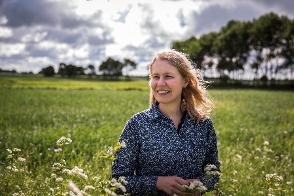
My area of research is agronomy and cropping systems with a focus on crops including soybeans, corn, and wheat, and a range of soil management practices from residue management, strip tillage, to cover crops. My research involves both small plot and on-farm field scale agronomy research. I enjoy communicating the results of my research to a wide range of audiences including farmers, agronomists, scientist in a range of disciplines, and especially in the classrooms where I teach at the University of Manitoba.
What kind of work do you do? As a professor, I teach about crop production and soil management every day. It may be in a large class, a small class, mentoring graduate students, or giving a presentation to agronomists and farmers. I love my job because I also get to ask new questions and learn every day. I work with graduate students to research new ways to grow food that are reliable for farmers, good for our environment, and healthy for us to eat. My research looks at ways to improved crop and soil management on the Canadian prairies. Farmers have to make many decisions about how to grow their crops. Some of the decision we are examining in my research include: seeding rates, planting dates, fertilization, crop rotation, cover crops, and residue management. I am always excited to tell farmers about what we have learn from our experiments and to hear what new questions they have about growing crops or managing soil on their farms.
What did you like to do when you were a kid? When I was young, I loved to collect things from nature. I had a rock collection. I would pick up sticks everywhere I would find them. I spent hours finding acorns under the oak tree in front of my house. There were so many different types of flowers, leaves, and plants to find in the garden. When I was in school and university I loved learning how to identify, compare, and organize all these things I found in nature.
Caroline Halde, Professor, Département de phytologie Université Laval

I am an assistant professor in agroecology at Université Laval in Quebec City, QC, Canada. I grew up on an organic dairy farm near Montreal, QC and received a B.Sc. in Agronomy from Université Laval, a M.Sc. in Agriculture from Dalhousie University, and a Ph.D. in Plant Science from the University of Manitoba. I completed postdoctoral studies in plant ecology at Cornell University, working on weed control in organic farming systems. My research interests are interdisciplinary and include agronomy, soil health, weed ecology, and cover crops.
What kind of work do you do? As a university professor, I mentor students in their learning process about agriculture. I lead the Agroecology Lab at Université Laval, a research team investigating the impact of farming practices on soil health and crop production. Along with my team, I design and conduct field and lab experiments to test innovative farming practices, in collaboration with farmers. I also teach ecological farming to undergraduate and graduate students. Finally, I serve on a number of university committees, performing a variety of administrative duties.
What is your favourite soil? My favourite soil is the Sainte-Rosalie, a Orthic Humic Gleysol found in the St. Lawrence Valley in Quebec, Canada. This Gleysol is derived from marine deposits accumulated at the time of the Champlain Sea. It is a well-structured soil, with very fine clay, poorly drained, and rich in organic matter in the surface horizon. When drained, soils from the Sainte-Rosalie series are very fertile. It is the 3rd series of soils in importance among the soils mapped in Quebec. The Sainte-Rosalie soil, present on my family farm in southern QC, has been farmed by my ancestors for more than 200 years.
The general process by which soil gradually declines in quality and is thus made less fit for a specific purpose, such as crop production. See erosion.
An approach to soil condition analogous to human or community health, by which the condition of a soil's properties and morphology are assessed against some optimum condition (i.e., soil-as-an-organism), or a soil's functions assessed against the goals placed upon them (i.e., soil-as-a-community), or against an optimum functional state. Often soil health is used synonymously with soil quality, except that a soil may have poor inherent soil quality but still have good health.
The tangible and intangible benefits humans gain from ecosystems (e.g., food, waste assimilation, aesthetic, nutrient cycling).
Six management practices land managers can use to build soil health. The six C's are: 1. compaction reduction, 2. conservation tillage, 3. crop + animal diversity, 4. continuous living plants, 5. cover crops, and 6. compost + organic amendments. The letter C was purposefully chosen to emphasize the role of carbon in soil health.
The various roles that soil performs, or the tasks that are placed upon soil, that underpin the concept of soil quality. Soil functions in three main ways: as a medium for plant growth, a regulator or partitioner of water and energy, and an environmental buffer or filter.
The capacity of a soil to recover its qualitative functions and dynamic properties, generally in a relatively short time frame, after some disturbance; an aspect of soil [health]quality.
A system comprised of soil, crop, weeds, pathogen, and insect subsystems that transforms solar energy, water, nutrients, labor, and other inputs into food, feed, fuel, or fiber. The cropping system is a subsystem of a farming system.
(1) Increasing soil bulk density, and concomitantly decreasing soil porosity, by the application of mechanical or other forces to a soil. As soil compaction increases, a state of excessive compaction can be reached that adversely affects plant growth. (2) The mechanical reduction of the volume of solid waste (an increase in density) by the application of pressure.
A void or space in a soil or rock not occupied by solid mineral material. The part of the bulk volume of soil not occupied by soil particles. Also called interstices or voids.
The mechanical manipulation of the soil profile for any purpose. In agriculture it is usually restricted to modifying soil conditions and/or managing crop residues and/or weeds and/or incorporating chemicals for crop production.
A subsurface soil layer, of varying thickness, which has a higher bulk density and lower total porosity than the soil material immediately above or below it. Normally occurs just below the maximum depth of tillage and is related to pressure from tractor tires and tillage implements. Also called plow sole.
The creation of channels through layers of soil compaction by plant roots. When left undisturbed, these channels allow the roots for subsequent crops to growth through the compaction layer.
A crop used primarily for the purpose of protecting and improving the soil between periods of regular crop production, or between rows of permanent standing crops (e.g., orchards and vineyards).
A prepared area in which seed is sown. In natural regeneration, the soil or forest floor on which seed falls.
Any tillage sequence, the object of which is to minimize or reduce loss of soil and water; operationally, a tillage or tillage and planting combination which leaves 30% or greater cover of crop residue on the surface.
A primary broadcast tillage operation performed to shatter soil with partial to complete inversion.
The practice of growing different crops in a planned regular sequence or succession on the same land. Usually established for economic considerations, especially to aid in the control of insects and diseases, maintain soil fertility, and decrease soil erosion.
Crop production systems that attempt to rely solely on organic matter or natural materials for crop production. They avoid and largely exclude the use of synthetic fertilizers, pesticides, growth regulators, and livestock feed additives. Organic farming relies instead on crop rotations, crop residues, animal manures, legumes, green manures, off-farm organic wastes, mechanical cultivation, mineral-bearing rocks, and biological pest control to maintain soil productivity and tilth, to supply plant nutrients, and to control insects, weeds, and other pests.
Land not being used to grow a crop, but cultivated or left untilled during the whole or greater portion of the growing season to preserve water, kill weeds, and increase soil nutrients. In arid and semi-arid regions, a fallow year is commonly used in crop rotations.
Any material released into soil from plant roots; includes water-soluble exudates, secretions of insoluble materials, lysates, dead fine roots, and gases.
(1) Edible parts of plants, other than separated grain, that can provide feed for grazing animals or can be harvested for feeding, including browse, and herbage. (2) To search for or to consume forage (of animals).
Land use system in which woody perennials are grown for wood production with agricultural crops, with or without livestock production.
Sowing a secondary crop [or cover crop] with the main crop to provide soil cover after the primary crop is harvested.
Crops that, under their usual management, tend to deplete nutrients and organic matter in the soil and permit deterioration of soil structure.
Soil conditioner and fertilizers produced from organic residues or a mixture of organic residues and soil, that have been piled, moistened, and allowed to decompose; often called artificial manure or synthetic manure.

